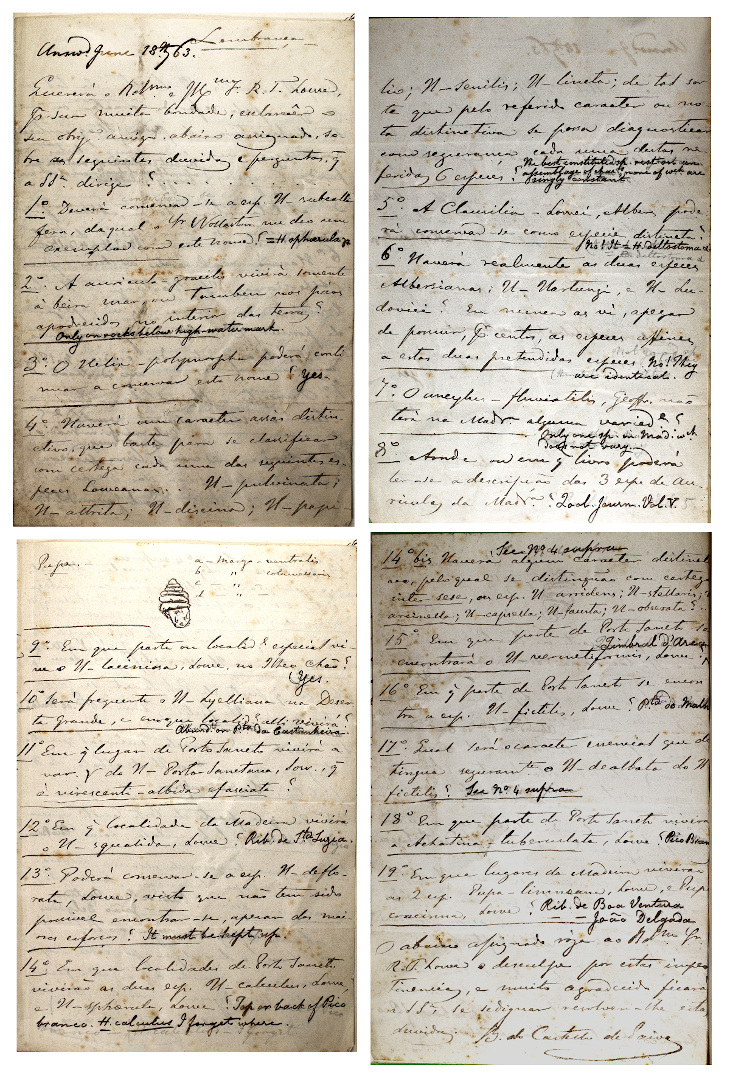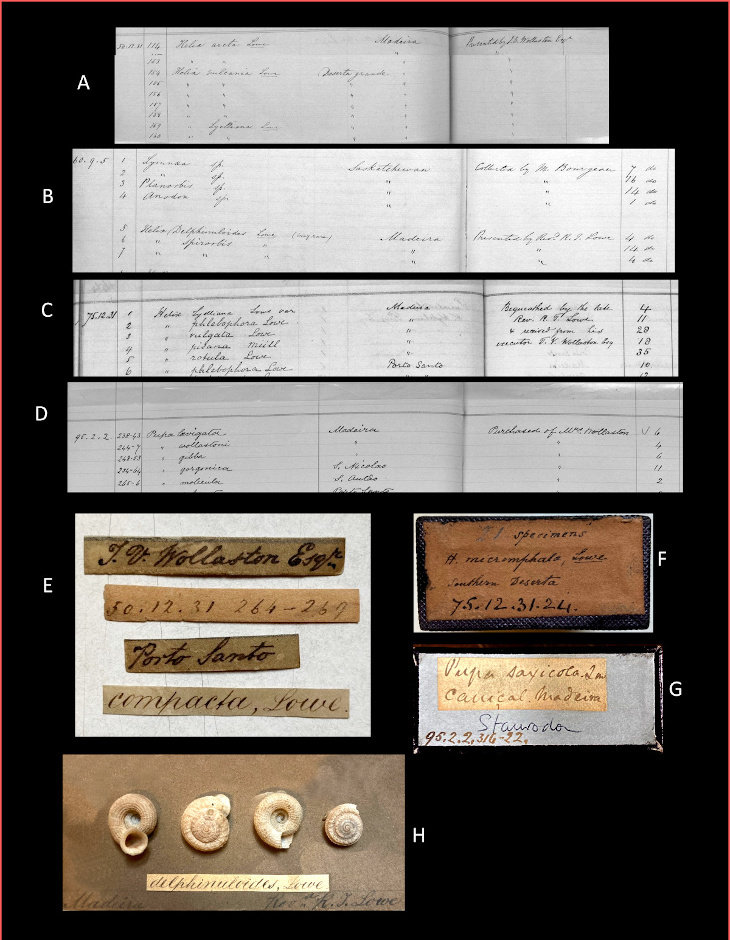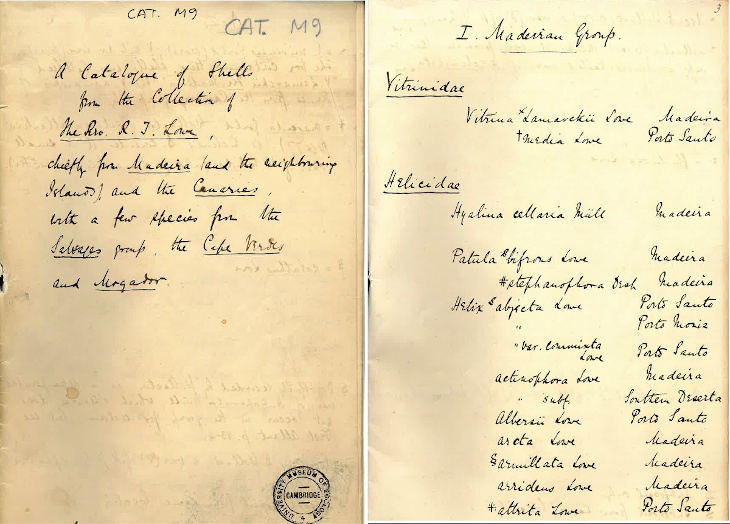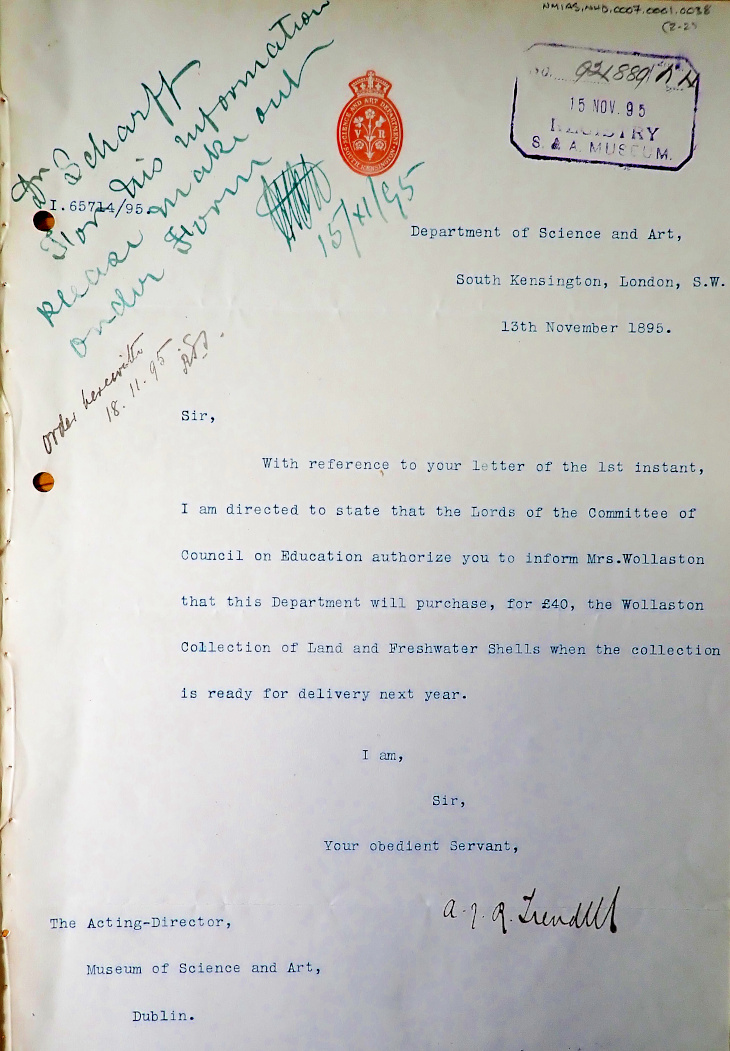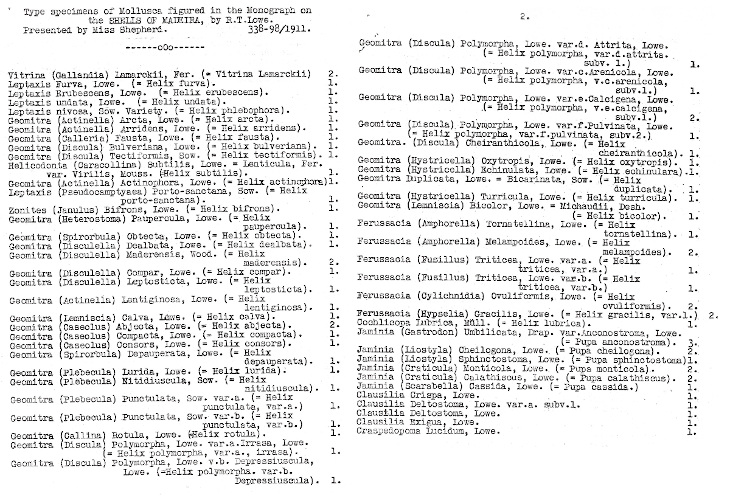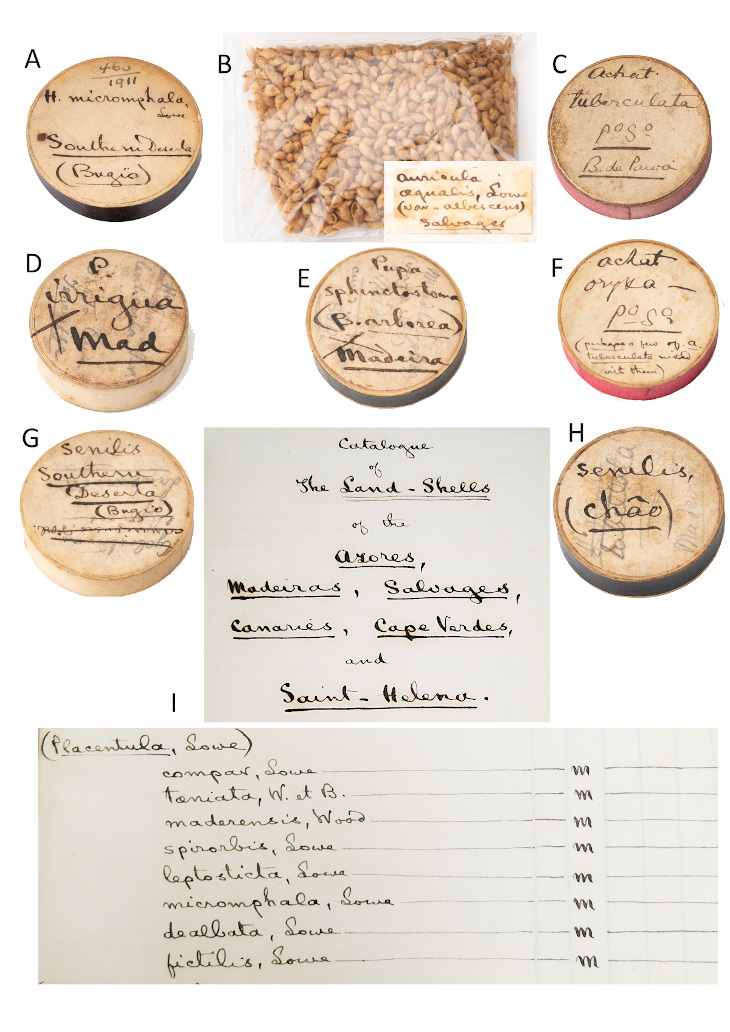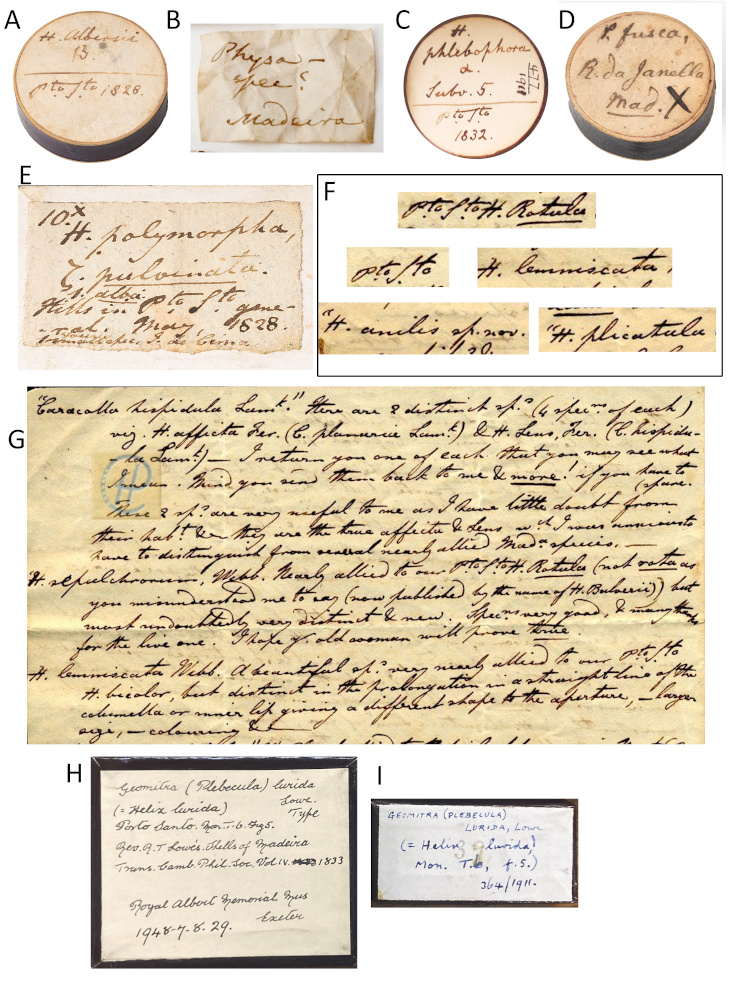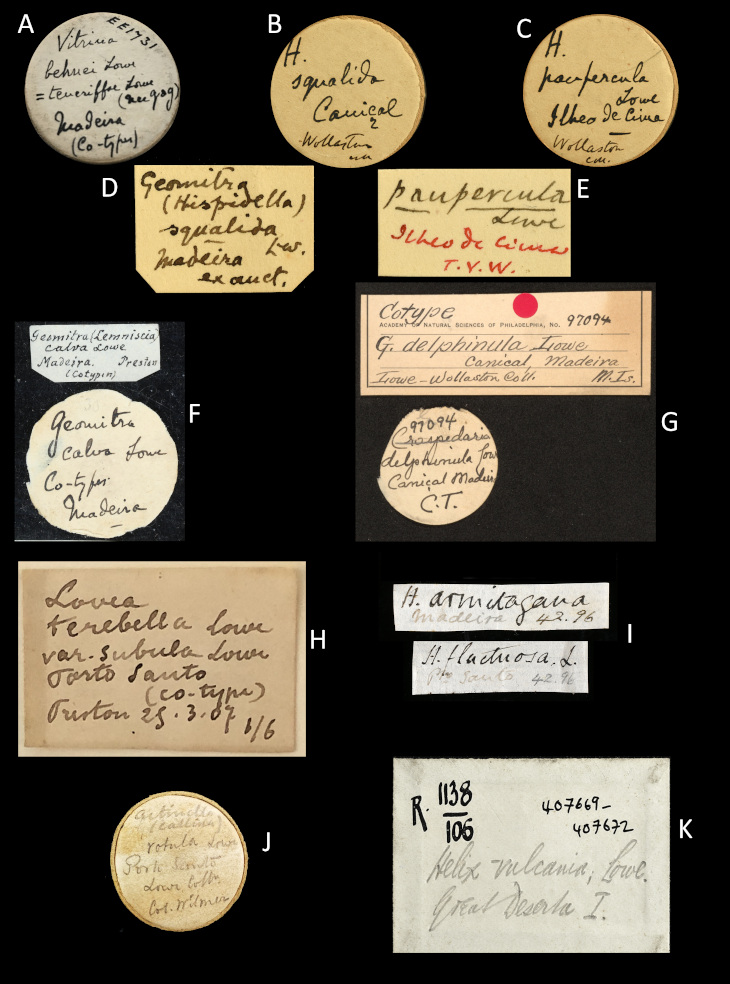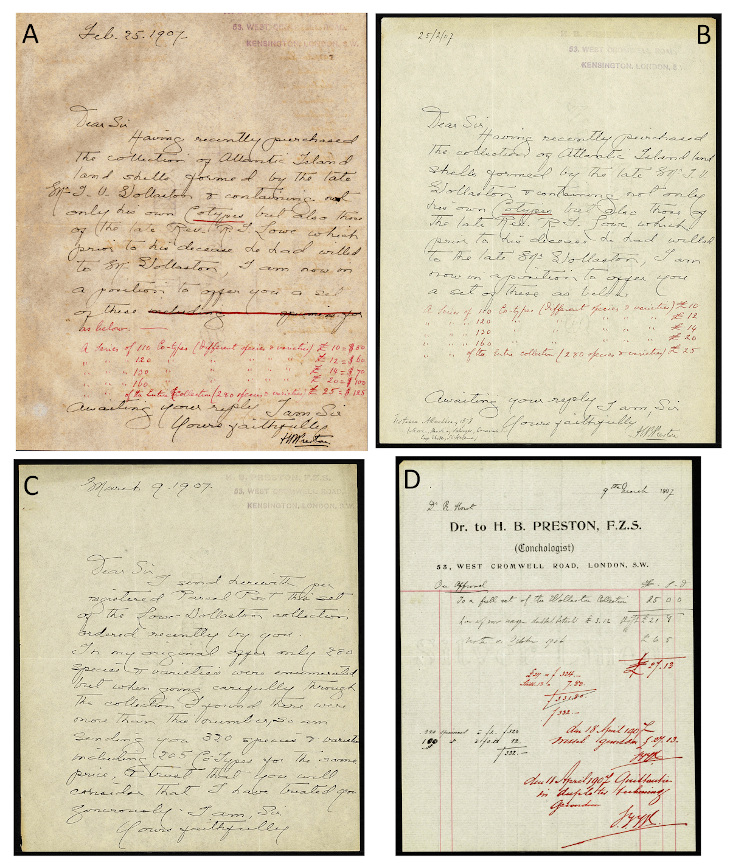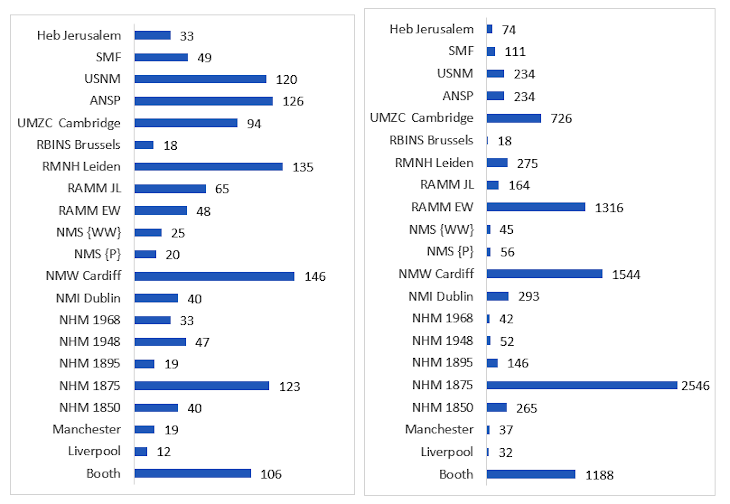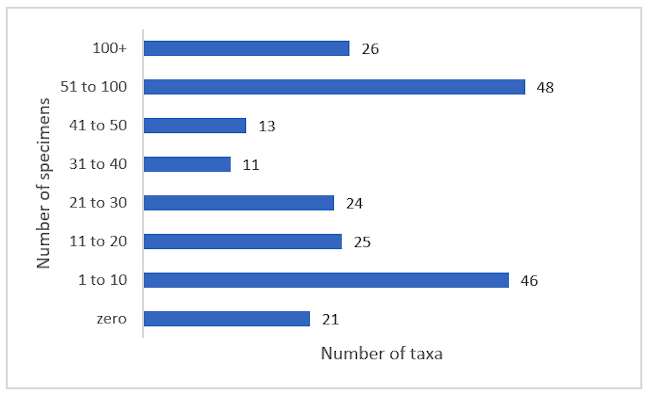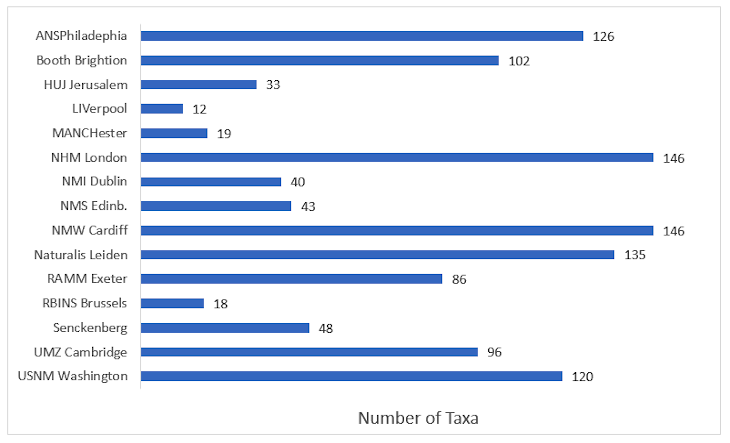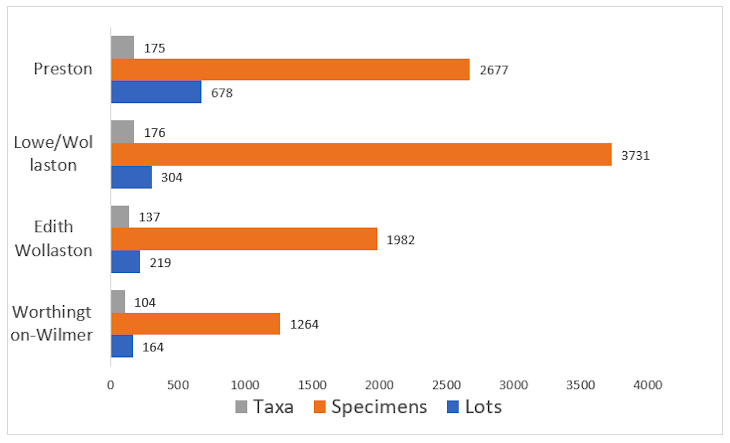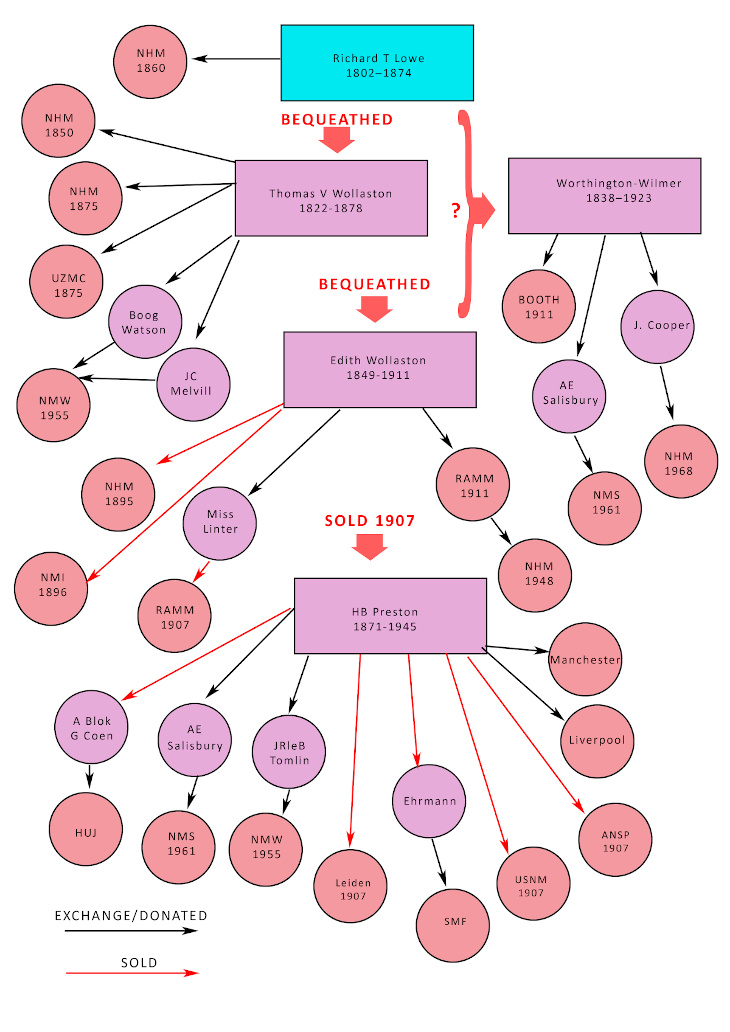Recognising Type Specimens in a Dispersed Collection. The Macaronesian Land Mollusca Described by R. T. Lowe
Reconnaître les spécimens types dans une collection dispersée. Les mollusques terrestres macaronésiens décrits par R. T. Lowe
- P. Graham Oliver, Klaus Groh, Jonathan D. Ablett, Thierry Backeljau, Bram van der Bijl, Amy Geraghty, Sigrid Hof, Lee Ismail, Henk K. Mienis, Holly Morgenroth, Richard C. Preece, Sankurie Pye, Gary Rosenberg, Ellen E. Strong, Jennifer Trimble & Harriet Wood
|
A catalogue of the dispersed collection of the land snails of the Macaronesian Islands described by and attributed to R. T. Lowe is presented. The provenance of the material which relates primarily to T. V. Wollaston, his wife Edith Shepherd, Col. L. Worthington-Wilmer and H. B. Preston is discussed. Parts of the dispersed collection have been located in fifteen institutions in the United Kingdom, Ireland, The Netherlands, Germany, Belgium, Israel and the United States of America. The list (Appendix 1) comprises 216 nominal taxa attributable to Lowe of which 9 are infra-subspecific, introduced as subvarieties. In addition 8 manuscript names have been included. Possible type material of all but 21 have been located, these comprising 17 varieties and 4 subvarieties. A total of 9537 specimens have been located. The verification of the type status is discussed and a ranking of the type resources is attempted. Evidence is lacking to either corroborate or dismiss the syntype status of the majority of the material but past nomenclatural acts have selected lectotypes from many parts. Furthermore many museums consider the co-types distributed by H. B. Preston to be of syntype status. Only the shells stated to be figured in the 1831 and 1860 papers can be considered as figured syntypes, and these are figured in Appendix 2. Keywords: Madeiran archipelago - Canary Islands - Museum collections - Evaluation of type specimens Un catalogue de la collection dispersée des mollusques terrestres de la Macaronésie décrits ou attribué à R. T. Lowe est présenté. La provenance du matériel qui concerne principalement T. V. Wollaston, son épouse Edith Shepherd, le colonel L. Worthington-Wilmer et H. B. Preston. Une partie de la collection dispersée se trouve dans quinze institutions au Royaume-Uni, en Irlande, aux Pays-Bas, en Allemagne, en Belgique, en Israël et aux États-Unis. La liste (Annexe 1) comprend 216 taxons nominaux attribuables à Lowe dont 9 sont infrasubspécifiques, introduits comme sous-variétés. De plus, 8 noms manuscrits ont été inclus. Parmi le matériel type possible, 21 ont été localisés, comprenant 17 variétés et 4 sous-variétés. Au total, 9 537 spécimens ont été localisés. La vérification du statut typique est discutée et un classement des critères de reconnaissance des types est tenté. Les preuves manquent pour corroborer ou rejeter le statut de syntype de la majorité du matériel, mais des lectotypes ont été sélectionnés lors d'anciens actes nomenclaturaux dans de nombreux groupes. En outre, beaucoup de musées considèrent les cotypes distribués par H. B. Preston comme ayant le statut de syntype. Seuls les coquilles qui ont servi aux figures dans les articles de 1831 et 1860 peuvent être considérées comme des syntypes figurés, et ceux-ci sont illustrés en annexe 2. Keywords : Madeiran archipelago - Canary Islands - Museum collections - Evaluation of type specimens |
Sources of possible type material
Rev. Richard Thomas Lowe (1802–1874)
Thomas Vernon Wollaston (1822-1878)
Col. Lewis Worthington-Wilmer (1838–1923)
Hugh Berthon Preston (1871–1945)
Appendix 1: A list of dispersed material linked to the R. T. Lowe collection
Appendix 2: Photographs of specimens from the 1948 accession of figured specimens from Lowe, 1831)
|
In a recent paper Oliver, Groh & Ismail (2022) reported the discovery of 103 lots of syntypes of land snail species described by Richard Thomas Lowe from Madeira and the Canary Islands. This collection was donated to the Booth Museum of Natural History in Brighton by Col. Lewis Worthington-Wilmer in 1911 and was stated to be derived from the collections of Lowe. The process of assessing the type status of this material led to a wider ranging review of other material, linked to Lowe, in museums across the UK, Europe, the USA and Israel. This review led to the unexpected discovery of over nine thousand specimens that could possibly represent syntypes in 15 museums. Both projects arose from the "Mollusca Types in Britain and Ireland" initiative funded by the John Ellerman Foundation to create an online database of all molluscan primary types in UK museums available at https://gbmolluscatypes.ac.uk (Ablett et al. accessed June 8 2023) This situation has arisen primarily from the initial lack of designation of any type specimens by Lowe, and his failure to deposit any type specimens in museums, a problem exacerbated by his untimely death by drowning in a shipwreck in 1874 (Foote, 2004). During the assessment we noted that lectotypes had been selected from a number of collections in the NHM, ANSP, RMNH and SMF (De Mattia, Groh & Neiber, 2018; Gittenberger, 1991; Groh & Hemmen, 1984, 1986; Hutterer & Groh, 1993; Ponte-Lira, Alonso & Ibáñez, 1997; Teixeira, Pokryszko, Cameron, Silva & Groh, 2019), but the entirety of available material in collections associated with R. T. Lowe is not or only sporadically cited. This was probably due to the lack of catalogued material, attributable to R. T. Lowe, present in so many museums. In this paper we attempt to catalogue the material that is presumed to have been part of Lowe's private collection from which type material has already been recognised or can be derived. Included is material of manuscript or infrasubspecific status and as such neither the names nor the specimens have any nomenclatural status but are included for curatorial convenience. We do not make any statements that could be considered a nomenclatural act, neither do we give specific type status to any of the material unless previously done so and already published. Material sold by Hugh Berthon Preston and labelled 'co-type' has by many museums been considered to be of syntype status thus suggesting that all of the material originating from Lowe's collection is also of syntype status. The purpose of the paper is to make available to the research and conservation communities the breadth of historical material linked to Lowe's original collection. Thus, taxonomic revisions will have the full extent of historical material on which to make nomenclatural decisions. We begin by considering the actions of Lowe himself before reviewing the parts played by other major players responsible for the dispersal of collections of Macaronesian land snails made by Lowe following their acquisition by Thomas Vernon Wollaston in 1874. In the appendix we give a catalogue of the possible type material that we have located noting that more such material may exist especially any further series sold by Preston. In the discussion we consider which of these collections could be given greater type significance based on their provenance.
Compiling a list of a dispersed collection relies on a historical perspective of the author, the names introduced and the whereabouts of relevant material. The list of taxa introduced by Lowe can largely be extracted from MolluscaBase but it is not totally comprehensive and intimate knowledge from current researchers, in this case Klaus Groh, is needed. Bibliographies, obituaries and papers on the location of collections give a relatively good idea of where a collection might be. Two sources are good places to start, they are Dance's "A History of Shell Collecting" (Dance, 1986) and "2400 Years of Malacology" (Coan & Kabat, 2023). However, unrecognised holdings can be discovered, such as that here from the Booth Museum of Natural History, Brighton. Ultimately the research relies on the curators and collection managers who are able to recognise the relevant material. A sad decline in specialist malacological curators has made this process more difficult but in the UK and Ireland attempts to overcome this were made via the "Mollusca Types in Britain and Ireland" project (Ablett et al., 2023) and while a global search of museums would be ideal it is not feasible and the approach here was to focus on likely repositories relating to the people who handled the collection. Confirming the provenance of material can be problematic as, in this case, specimens from the Lowe collection were given to a variety of friends and then from friend to friend distancing the shells from their original ownership. Given the final scale of this project it was not possible to verify the identity of the specimens in all of the collections found. Here only the identity of the 1948 accession in the NHM have been confirmed by Klaus Groh and he also verified the identities of the shells in the Booth Museum of Natural History, Brighton. Taxonomists, in defined areas, will be required to verify identifications and it is our hope that they will now consult the entire range of sources of material available. Institutional Abbreviations: ANSP: Academy of Natural Sciences, Philadelphia BM(NH): former name of the Natural History Museum London BOOTH: Booth Museum, Brighton HUJ MOLL: Hebrew University Museum, Mollusca, Jerusalem LIV: National Museums Liverpool LIVCM: registration code for Mollusca collection in National Museums Liverpool MANCH: University of Manchester Museum NHM: Natural History Museum, London, formerly British Museum (BM) prior to 1881 and British Museum (Natural History) from 1881 to 1992 NHMUK: registration code for Natural History Museum, London NMINH: National Museum of Ireland, Natural History, Dublin NMS: National Museums of Scotland, Edinburgh NMW: Amgueddfa Cymru, National Museum of Wales, Cardiff RAMM: Royal Albert Memorial Museum, Exeter RBINS: Royal Belgian Institute of Natural Sciences, Brussels RMNH: Rijksmuseum van Natuurlijke Historie, now Naturalis, Leiden SMF: Senckenberg Museum Frankfurt / Main UMZC: University Museum of Zoology Cambridge USNM: United States National Museum, Washington
Sources of possible type material Rev. Richard Thomas Lowe (1802–1874) A brief biography relevant to Lowe's work on the Mollusca is given in Oliver, Groh & Ismail (2023). Lowe was a prolific naturalist who described some 216 nominal land molluscan taxa from the Macaronesian islands, as well as producing monographs on the botany of Madeira (see Mesquita et al., 2020, 2021, 2022) and the fishes of Madeira (Lowe, 1838, 1843-1860, 1849). Lowe lived on Madeira as a practising clergyman, arriving in 1826 and resigning in 1847 but continuing to visit the island until his death in 1874. There is a strong connection with Christ's College, Cambridge as both his friend T. V. Wollaston and his correspondent P. B. Webb were fellow members of the College. Another malacological correspondent was Baron de Paiva (alias Antonio da Costa Paiva and Baron de Castello de Paiva) and inserted in a copy of his monograph (Paiva, 1867) dedicated to Lowe, is a letter to Lowe. This letter (Fig. 1), dated June 18 1863, seeks Lowe's opinion on a number of matters against which Lowe has inserted annotations. Many of these ask for the locations where certain species can be found and Lowe was happy to give such details. In the Shepherd collection in RAMM, Exeter are specimens from Paiva (Fig. 7) to either Lowe or Wollaston. A large collection made by Paiva is held by the Museu da Ciência da Universidade de Coimbra (Breves, Pereira and Girao Da Cruz, 2022) and may well contain specimens given by Lowe and/or Wollaston. Sadly Lowe, Wollaston and Paiva all died within the space of five years. During his lifetime Lowe did deposit specimens in the then BM now the NHM but very few were molluscs and only three were land snails. Under 1860.9.5.5–7 (Fig. 2B) he donated shells of Helix delphinuloides R. T. Lowe, 1860 (Fig. 2H) and H. spirorbis R. T. Lowe, 1852. Why he should have chosen these two species and no more, remains an enigma. From his 1860a paper Lowe was obviously excited by the discovery of H. delphinuloides, giving great details of the habitat and a very lengthy description including figures. The labels with these specimens are not in his hand-writing but are museum generated. Although he restricted his published research to land snails he had a much wider interest including marine molluscs. This is evidenced by manuscript notes (Fig. 3) on visits to the BM in September and November 1859 when he was examining marine shells from the Canaries and shells in the R. McAndrew 1 collection. Lowe had collected marine shells at Mogador (now Essaouira) on the west coast of Morocco and was attempting to identify them, which included a discussion with the famous collector Hugh Cuming (see Dance, 1986). These 4 sides of notes were given to Robert Boog Watson by Wollaston in 1876 and are some of the very few examples of Lowe's hand-writing; and are now in the archive of the NMW.
On Lowe’s death his collections were bequeathed to his friend and colleague T. V. Wollaston. Thomas Vernon Wollaston (1822-1878) Wollaston was a long-time friend of Lowe, both having studied at Christ's College, Cambridge and both attended the lectures on natural history given by Henslow (Foote, 2008). Wollaston was primarily an entomologist interested in biogeography but after Lowe's death he became the expert on Macaronesian land snails publishing his Testacea Atlantica in the year that he died (Wollaston, 1878). Upon Lowe's death Wollaston acquired Lowe's entire collection which he had intended to donate to museums as well as retain material for his own study (see Wollaston, 1878). Although Wollaston (1878) stated that he would donate collections to museums after Lowe's death in 1874 two earlier donations (Fig. 2A) were made by him in 1849 (NHMUK 1849.6.30) and 1850 (NHMUK1850.12.31) to then BM. It is likely that these acquisitions represent a single donation that was registered over the two consecutive years. This collection consists of 221 specimens representing 38 nominal taxa. There is nothing in the museum register to indicate that this material came from Lowe nor are the labels in Lowe's hand (Fig. 2E). Specimens of Helix (Irus) laciniosa, H. (Tectula) lyelliana and H. (Leptaxis) vulcania are named (Fig. 2A) but these were not described by Lowe until 1852 (Lowe, 1852). It therefore seems logical that this material had been given to Wollaston by Lowe or had been identified by Lowe and could be considered as a source of type specimens. Wollaston first visited Lowe in Madeira in 1847 during which he could have made this collection. After Lowe's death Wollaston donated two collections, one to the BM and the second to the University Museum of Zoology Cambridge (UMZC). Both are noted as posthumous bequests from Lowe. The collection donated to the BM(NH) is registered under NHMUK 1875.12.31 but as above the labels are not original (Fig. 2C, F) This collection consists of 2546 specimens representing 120 nominal taxa and is one of the largest in both specimens and species represented. In the same year Wollaston donated a similar collection to the University Museum of Zoology, Cambridge (UMZC 1875) which was catalogued in 1882 by the Rev. A. H. Cooke 2 (Fig. 4). This collection as catalogued by Cooke contained 96 nominal taxa but due to later activities this was partially mixed with other collections and the provenance has been lost. As a consequence, only 25 species can be directly linked to the Wollaston donation but 796 specimens are present indicating the large number of specimens in each lot. Despite Wollaston's intentions he donated only specimens of 120 taxa out of the 224 described by Lowe.
In the intervening years between acquiring Lowe's collection and his death in 1878, Wollaston did disperse specimens from Lowe's collection but regarded them as duplicates. In a letter (NMW archives) dated Sept. 19, 1877 Wollaston wrote to Robert Boog Watson "The second parcel, and which I sent up to Mr. Rye by train about a week ago, contains only such few Canarian species as I was able to muster for you, from my own and Mr Lowe’s duplicates, - for you to retain. I am sorry that I could not lay my hands on more ........ I have not managed to get you together much over 50 species, - the names of wh[ich] you will find on the enclosed memorandum". Watson was primarily interested in marine Mollusca but wrote three papers on Macaronesian land and freshwater snails (Watson 1876; 1877; 1892). Material in the Watson collection may be Lowe's duplicates but Wollaston also secured new material for Watson as stated in Watson, 1877. Parts of the Watson collection can be found in the National Museum of Wales probably acquired by J. R. le B. Tomlin. Wollaston died only four years after Lowe in 1878 and the entire Lowe/Wollaston material remained with Wollaston's wife Edith. Edith Wollaston (née Shepherd) (1849est–1911) Edith Wollaston 3 was, like her husband, an entomologist and accompanied him on his collecting expeditions. In 1879 she published on the Lepidoptera of St. Helena describing 37 species new to science (Wollaston E, 1879a, b, c). Although she retained the Mollusca collection little is mentioned of it by others but after a decade she began selling parts of it. In 1895 Edith sold a collection to the BM(NH) (NHMUK 1895.2.2) (Fig. 2D, G) that consisted of 146 specimens representing 18 species of which 13 were not in her husband's 1875 donation. At some time during the 1890's Edith sold or gave to the private collector Juliana Linter (Morgenroth et al., 2018) 164 specimens representing 65 species. This material remained within Linter's collection which was bequeathed to the Royal Albert Memorial Museum, Exeter (RAMM) in 1909 under the acquisition EXEMS:1720/1909. Then in 1896 Edith sold (Fig. 5) a collection to the National Museum of Ireland (NMINH 1896.42). The sale was brokered by Edgar L. Layard 4 and consisted of both Lowe and Wollaston species. This portion of Lowe species consisted of 293 specimens representing 40 taxa for which she received £40, equivalent to £4900 today.
In 1907 Edith sold most of the remaining Lowe/Wollaston material to H. B. Preston, a shell dealer based in London. Preston had started to sell series of Lowe and Wollaston type material in 1907 but became concerned when he discovered that another collection had been donated to the Royal Albert Memorial Museum in Exeter in 1911, which might undermine the status of his material. In 1912 Preston wrote to the curator in Exeter "I don't think that Lowe and Wollaston ever actually described from a single type as is the custom today, but used a whole set for their description, thus there were never any actual types, but a number of Co-types for each species". This conclusion is somewhat questionable as Wollaston, on page 269 of his Testacea Atlantica, wrote “It is surprising to me that Mr Lowe in his original description of the species should have failed to notice this tendency for spiral striae but as I happen to be aware that many of his earlier diagnoses were drawn out of a very limited number of individuals ---“. This collection was donated by a Miss Shepherd and registered under EXEMS:338–477/1911. Miss Shepherd was one of Edith Wollaston's sisters and this collection was a portion kept by Edith and not sold to Preston. When this collection was acquired, it came with the statement that it contained a number of specimens figured by or for Lowe in his 1831 paper (Lowe, 1831). These specimens (EXEMS:338-398/1911) were subsequently transferred to the BM(NH) in 1948 while the remaining material, consisting of over 1000 specimens representing 45 species, was retained in Exeter. The transferred material is registered in London under NHMUK 1948.7.8 while the Exeter material remains under RAMM 399–477/1911. The 1948 transfer as listed in the Exeter register (Fig. 6) consisted of 52 specimens representing 46 taxa and these have been located in the NHM. Lowe (1831) introduced 70 new nominal taxa in 1831 and illustrated 65 so it appears that not all were painted or not isolated before being donated to RAMM. The figured shells from the 1948 accession are illustrated here in Appendix 2 (Plates 1–7) and have been identified by Klaus Groh. While these match the species illustrated in Lowe (1831) (Plates 8–11) one cannot say with certainty that the photographed shells are those figured by Lowe (1831) mostly these are very small and individual markings cannot be discerned. In a letter dated April 1991 to the then curator of natural history in RAMM, Fred Naggs of the NHM cast doubt on the authenticity of these specimens being those actually figured but did consider them to be syntypes. Doubt stems from the lack of any original labels linked to these specimens, those present were added after the collection was transferred to the BM(NH) (Fig. 8H, I). However, among the material remaining in RAMM there are labels that can be identified as those of Lowe (Fig. 8) although the majority are by Wollaston (Fig. 7). RAMM possesses a hand-written manuscript pertaining to Wollaston's Testacea Atlantica in which most species are listed and thus direct comparison can be made with the labels in the collection (Fig. 7). It should be noted that Wollaston's hand-writing does not have a consistent style being cursive in sentences but less looped, more rounded on labels and in lists. His abbreviation of "Po So" for Porto Santo is distinctive and quite different from that used by Lowe (see below).
The few that can be linked directly to Lowe can be identified by comparison with the hand-writing in Lowe's letters to Webb (Fig. 8). Very distinctive is the form of the abbreviation for Porto Santo, the forward leaning style and similarity in individual letters such as the p, sp, and the capital H with the bold complete horizontal element. The use of Greek letters to denote varieties is also typical of Lowe as seen in Lowe (1831) for "ζ pulvinata" as on the label illustrated here (Fig. 8E). Unlike most other collections, that retained in RAMM also has a selection of original containers some with more detailed locality information and date of collection. Figure 8D is of Pupa fusca from R. da Janella, a locality not mentioned in any of Lowe's papers. Those labelled with dates such as 1828 or 1832 (Figs 8A, C, E) must have been collected by Lowe because Wollaston who did not make his first visit to Madeira until 1847 whereas Lowe first visited in 1826. The parts of the Shepherd collection that remained in pill-boxes are probably the best representation we have of the collection as it was when acquired by Preston. The majority of labels are by Wollaston with only a few by Lowe and collection details are rare throughout. Of added interest are those indicating that they were given by Baron de Paiva to Lowe or Wollaston (Fig. 7b). Some of the lots in RAMM contain many hundreds of specimens and if Preston was selecting his "co-types" from such lots it throws considerable doubt on the possible type status of some shells distributed by Preston. Col. Lewis Worthington-Wilmer (1838–1923)
After Edith Wollaston's death only two sources of possible Lowe type material remain, those dispersed by L. Worthington-Wilmer and Preston. Oliver et al. (2022) reported on the 1188 specimens in 111 lots representing 103 taxa present in the Booth Museum, Brighton. This material was originally donated to the Brighton Museum in 1911 under the accessions R1138 and R1145 and has been recently item catalogued by Oliver et al. (2022). They considered these to be of syntype status in keeping with the donation to the BM(NH) in 1968 which was also linked to Worthington-Wilmer. That collection (NHMUK 1968.536 – 1968.588) comprised 42 specimens representing 33 species. Lectotypes have been selected from this collection including one (NHMUK 1968.586) for Hystricella echinulata (Lowe, 1831) selected by De Mattia et al., (2018). Material linked to Worthington-Wilmer is also present in the National Museums of Scotland contained within the A. E. Salisbury 5 accession NMS Z.1961.61. Forty-five specimens representing 25 taxa are present and labelled "Col. Wilmer ex Lowe" (Fig. 9J) and these therefore have the same status as the Worthington-Wilmer donations to the BM(NH) and Booth Museum. Other lots are a mixture of shells attributed to Col. Worthington-Wilmer, Tomlin 6 and or Watson 7. We will return to latter collectors under the review of material originating from Preston 8. Oliver et al. (2022) were unable to locate the source of the shells acquired by Worthington-Wilmer but the Brighton Museum accession archive states that the shells were selected from the Lowe collection. This leaves only three possibilities, directly from Lowe before 1874 from Wollaston before 1878 or from Edith Wollaston before she sold the collection to Preston in 1907. Hugh Berthon Preston (1871–1945) Once the bulk of the collection passed into the possession of Preston he immediately began to sell series of Lowe and Wollaston types to collectors and museums. These he regarded as co-types and in many museums, these are now accepted as syntypes. Within the United Kingdom and especially centred around the BM(NH) were a cohort of private collectors who exchanged and bought and sold shells. These collectors included Tomlin, J. C. Melvill 9 and Salisbury, and it is through these people that Preston's co-types are now found in Cardiff (NMW.1955.158), Edinburgh (NMS 1961.61), Manchester and Liverpool. The provenance of the historical material in the NMW, Cardiff is particularly complex as it includes Preston co-types; material labelled 'ex auct Lowe' by Tomlin; ex TV Wollaston indicated by Melvill and material from Watson's collection also labelled as from Wollaston. A selection of labels is given in Figure 9. Preston, himself, was part of this cohort of collectors and may have exchanged specimens especially with Tomlin who subsequently exchanged with others such as is seen in the Salisbury collection in Edinburgh. Tomlin and Melvill would have been very aware of the Lowe/Wollaston collection residing with Edith and may well have received shells directly from her in the same manner that Juliana Linter acquired material. Melvill who was born in 1845 could have in his early days as a collector corresponded directly with T. V. Wollaston who died when Melvill was aged 33. We have therefore listed as possible syntypes all of the material in the Tomlin collection that carries ex Lowe or ex Wollaston indications as well as those coming directly from Preston. Of the UK museums holding material from Preston are Cardiff (144 taxa), Edinburgh (20 taxa), Manchester (19 taxa) and Liverpool (12 taxa).
Preston also sold co-type series to museums and collectors in Europe and the USA with the largest series going to ANSP (234 specimens in 125 taxa), Smithsonian (234 specimens in 118 taxa) and Leiden (275 specimens in 119 taxa). Smaller series have been found in the Dautzenberg 10 collection in RBINS and the Ehrmann 11 collection in SMF. The MCZ in Boston holds a considerable collection of Madeiran land snails but these were acquired from Baron de Paiva (1806-1879)12, a contemporary of Lowe and Wollaston; at this time we do not know if any were acquired directly from Lowe or Wollaston or were collected by himself. Labels in the Shepherd collection in RAMM, Exeter indicate that shells were exchanged between Paiva and Lowe/Wollaston and this provenance was probably passed on by Preston. The archives of the ANSP and Leiden hold offers of sale, dated 25/2/1907, (Fig. 10) from Preston in which he was initially offering up to 280 species including 160 co-types of species or varieties described by Lowe and Wollaston. To Leiden he was later to change his offer to 320 species including 205 co-types after stating "In my original offer only 280 species & varieties were enumerated but when going carefully through the collection I found there were more than this number". The sale price of £25 or 125$ equates to between 4,500$ and 8,000$ in today's money (https://www.measuringworth.com/aboutus.php). Preston ceased trading in 1915 and his stock was sold at Steven's auction house on 6th December of that year (Winckworth, 1947). Arthur Blok (1882-1974) 13, a private collector bought at this sale and acquired many co-types that were subsequently bequeathed to the Hebrew Museum in Jerusalem (Mienis, 2021). Mienis also reports that Blok received co-types from other collectors such as J. R. le B. Tomlin. Mienis (2021) states the Italian collector G. S. Coen (1873-1951) 14 also bought shells from Preston and these too are in the Hebrew Museum. In total in the Hebrew museum are 74 specimens representing 33 taxa.
Fifteen museums have been found to hold material from the dispersed Lowe collection in which there are possible type specimens. This amounts to 9537 specimens that were derived from 21 different donations (Fig. 11), the largest in numbers of specimens being that made by T. V. Wollaston to the BM in 1875. Of similar size was the donation that Wollaston made in the same year to the UMZC but the number of specimens included in this donation is now difficult to determine. The large collection in the Melvill-Tomlin collection, Cardiff came primarily from H. B. Preston whereas the large collection in Brighton came from Worthington-Wilmer. On a museum basis the largest collection in the UK is in the NHM followed by the NMW, RAMM, Booth Museum, Brighton and UCZM.
The number of specimens representing a taxon is very variable ranging from 1 to 200 (Fig. 12), although, occasionally in RAMM, there are lots with many hundreds of specimens (Fig. 7B). Of the 216 nominal taxa described by Lowe only 4 species are not represented by possible type material although a further 21 varieties or subvarieties are also lacking named specimens. Forty-six taxa are represented by less than 10 specimens while 74 are represented by more than 50 specimens.
The missing nominal species are Helix lauta Lowe, 1831, which was listed as unique; Helix poromphala Lowe, 1852; Craspedopoma annulatum Lowe, 1860 and Helix concinna Lowe, 1861. Lectotypes have already been designated for 17 nominal taxa. The most representative series (Fig. 13) with over 100 taxa present are in the NHM London, NMW Cardiff, ANSP Philadelphia, USNM Washington, Booth Museum of Natural History Brighton and RMNH, Naturalis Leiden. Of these the NHM has most taxa with 146 but no museum has a complete representation.
The material came from four primary sources, T. V. Wollaston, his wife Edith, H. B. Preston and Col. Worthington-Wilmer. The largest number of specimens were donated by Wollaston but Preston distributed the largest number of lots but with only a few (1-4) specimens in each. The largest representation of taxa is the material sold by Preston as co-types (Fig. 14). While the size of the collection bought from Edith Wollaston by Preston is unknown it is probable that there were other buyers and that yet more possible type material exists in museum collections.
|
|
This project could not have been completed without the input of the curators and collection managers responsible for the relevant collections and consequently I (Graham Oliver) have acknowledged them all by including them as joint authors. While I have compiled this paper the taxonomy and nomenclature are the work of Klaus Groh, who also needs a special mention for his detailed editing. Special thanks go to the Natural History Museum London for providing the photographs of the shells in plates 1-7. Other images and archival elements were provided by the Academy of Natural Sciences, Philadelphia; Natural History Museum, London; Naturalis, Leiden; National Museum of Wales, Cardiff, National Museums of Scotland, Edinburgh, Royal Belgian Institute of Natural Sciences, Brussels; Royal Albert Memorial Museum Exeter; Senckenberg Naturmuseum Frankfurt/M; University Museum of Zoology, Cambridge. Thanks to Gary, Jon, Henk, Richard and Thierry for critical and helpful comments on the manuscript. |
|
Ablett J., Brown C., Gallichan J., Gordon D., Holmes A. M., Hunter T., Machin R., Morgenroth H., Oliver P. G., Petts R., Pye S., Reilly M., Rowson B., Salvador A., Sutcliffe R., Turner J. A., Wood H., 2019. Mollusca Types in Britain and Ireland. Amgueddfa Cymru-National Museum Wales / Natural History Museum. Available online at https://gbmolluscatypes.ac.uk (accessed: 8 June 2023). Badcock E. C., 1964. A. E. Salisbury, 1876-1964. Journal of Conchology, 25(7): 293–298, pl. 21. Benthem Jutting T. van, 1938. In Memoriam Paul Ehrmann. 21 Dez. 1868-6 Okt. 1937. Basteria, 3: 1–4. Breves A., Pereira G. & Girão de Cruz M. T., 2022. António da Costa Paiva (Barão de Castelo de Paiva) (1806–1879): his malacological collection from Madeira in Universidade de Coimbra, Portugal. Archives of Natural History, 49 (2): 311–318. Coan E. V. & Kabat A. R., 2019. 2,400 years of malacology, 16th ed. 1 February 2019, 1,712 pp. + 111 pp. [Annex 1 – Book Collations] + 65 pp. [Annex 2 – Küster Collation] + 62 pp. [Annex 3 – Journal Collations]. American Malacological Society: http://www.malacological.org/epubs.html Dance S. P., 1986. A history of shell collecting. Leiden, E. J. Brill-W. Backhuys, xv + 265 pp., 32 pls. De Mattia W., Neiber M. & Groh K., 2018. Revision of the genus-group Hystricella R. T. Lowe, 1855 from Porto Santo (Madeira Archipelago), with descriptions of new recent and fossil taxa (Gastropoda: Helicoidea: Geomitridae). ZooKeys, 732: 1–125. https://doi.org/10.3897/zookeys.732.21677 Foote Y., 2004. Lowe, Richard Thomas (1802–1874), naturalist. Oxford Dictionary of National Biography. https://doi.org/10.1093/ref:odnb/17087 (accessed: 8 June 2023). Foote Y., 2008. Wollaston, Thomas Vernon (1822–1878), entomologist and conchologist. Oxford Dictionary of National Biography. https://doi.org/10.1093/ref:odnb/29840 (accessed: 8 June 2023). Gittenberger E., 1991. On Cyprian Helicellinae (Mollusca: Gastropoda Pulmonata: Helicidae), making a new start. Zoologische Mededelingen, 65 (7): 99–128. Groh K. & Hemmen J., 1984. Revision der Gattung Boettgeria O. Boettger. Archiv für Molluskenkunde, 115 (1/3): 1–39. Groh K. & Hemmen J., 1986. Zur Kenntnis der Vitriniden des Madeira-Archipels (Pulmonata: Vitrinidae). Archiv für Molluskenkunde, 116 (4/6): 183–217. Hutterer R. & Groh K., 1993. A review of Macaronesian Truncatellina (Gastropoda: Vertiginidae) with descriptions of four new species. Bocagiana, 151: 1–19. Lowe R. T., 1831. Primitiae faunae et florae Maderae et Portus Sancti; sive species quaedam novae vel hactenus minus rite cognitae animalium et plantarum in his insulis degentium breviter descriptae. Transactions of the Cambridge Philosophical Society, 4 (1): 1–70, pls. 1–6. Lowe R. T., 1832. On the genera Melampus, Pedipes and Truncatella with experiments tending to demonstrate the nature of the respiratory organs of these Mollusca. Zoological Journal, 5: 280–305, pl. 13. Lowe R. T., 1838. Piscium Maderensium species quaedam novae, vel minus rite cognitae, breviter descriptae. Transactions of the Cambridge Philosophical Society, 6: 195–202, 5 pls. Lowe R. T., 1843–60. A history of the Fishes of Madeira, with original figures from nature of all species by the Hon.C. E. C. Norton and M. Young. London, 196 pp., 27 + 1 pl. Lowe R. T., 1849. Supplement to "A synopsis of the fishes of Madeira." Transactions of the Zoological Society of London, 3: 1–20. Lowe R. T., 1852. Brief diagnostic notices of new Madeiran land shells. The Annals and Magazine of Natural History, (2) 9 (50): 112–120; (2) 9 (52): 275–279. Lowe R. T., 1853. Primitiae et Novitiae Faunae et Florae Maderae et Portus Sancti or Two Memoirs on the Ferns, Flowering plants, and Land Shells of Madeira and Porto Santo with an appendix. J. Van Voorst, London. Lowe R. T., 1855 ["1854"]. Catalogus molluscorum pneumonatorum insularum Maderensium: or a list of all the land and freshwater shells, recent and fossil, of the Madeiran islands: arranged in groups according to their natural affinities; with diagnoses of the groups, and of the new or hitherto imperfectly defined species. Proceedings of the Zoological Society of London, 22: 161–208; 209–218. Lowe R. T., 1860a. Description of a new Helix; and notice of the occurrence of Planorbis glaber, Jeffr., in Madeira. The Annals and Magazine of Natural History, (3) 6 (31): 42–46. Lowe R. T., 1860b. The Cyclostomas of Madeira belonging to the genus Craspedopoma of Pfeiffer: with descriptions of four new Madeiran and one new Canarian species. The Annals and Magazine of Natural History, (3) 6 (32): 114–118. Lowe R. T., 1861. Diagnoses of new Canarian land-Mollusca. The Annals and Magazine of Natural History, (3) 7 (38): 104–112. Lowe R. T., 1862. Notice of the discovery, by the Barão do Castello de Paiva, of the fossil Helix coronula recent, and of other new land-Mollusca, in Madeira. The Annals and Magazine of Natural History, (3) 10 (56): 93–96. Lowe R. T., 1863. Description of two new Madeiran land-shells lately discovered by the Barão do Castello de Paiva and Sr J. M. Moniz. The Annals and Magazine of Natural History, (3) 12 (71): 338–340. Lowe R. T., 1867. Description of a new Madeiran Pupa. The Annals and Magazine of Natural History, (3) 19 (110): 81–82. MacAndrew R., 2008. Robert McAndrew FRS (1802-1873) - a family perspective. Archives of Natural History, 35 (1): 71–75. Mienis H. K., 2021. Revised catalogue of type samples of molluscs described by H. B. Preston present in the national mollusc collection of the Hebrew University of Jerusalem. Triton, 42: 23–36. Morgenroth H., Oliver P. G. & Breure A. S. H., 2018. The Miss J. E. Linter (1844-1909) collection of land snails in the Royal Albert Memorial Museum & Art Gallery, Exeter, England: A provisional assessment. Colligo, 1 (2). https://perma.cc/K7GA-DU9L Oliver P. G., Groh K. & Ismail L., 2022. Type specimens of Macaronesian land snails described by R. T. Lowe held in the Booth Museum, Brighton. A forgotten taxonomic resource. Colligo, 6 (1). https://revue-colligo.fr/?id=82 Pain T., 1976. Obituary Arthur Blok. Journal of Conchology, 29: 67-68. Paiva C. (de), 1867. Monographia molluscorum terrestrium, fluvialium, lacustrium insularium Maderensium. Memorias da Académia Real das Sciencias de Lisboa. Classe de sciencias mathematicas, physicas e naturaes, new series, 4 (1): 1–168. Ponte-Lira C. E., Alonso M. R. & Ibáñez M., 1997. Canariella (Simplicula) n. subgen. (Gastropoda, Pulmonata, Hygromiidae), de las Islas Canarias. Bollettino Malacologico, 31 (9-12): 221–230. Preece R. C., White T. S., Raheem D. C., Ketchum H., Ablett J., Taylor H., Webb K. & Naggs F., 2022. William Benson and the golden age of malacology in British India. Biography, illustrated catalogue and evaluation of his molluscan types. Tropical Natural History, Supplement 6: 1–434. Salisbury A. E., 1955. Obituary: J. R. Le B. Tomlin, 1864-1954. Journal of Conchology, 24: 29–33. Teixeira D., Pokryszko B., Cameron R., Silva I. & Groh K., 2019. Taxonomic revision of the late-Pleistocene/Holocene land-mollusc fauna (Gastropoda: Eupulmonata) of the Desertas Islands, Madeiran Archipelago, with the description of 6 new species and 2 new subspecies. Archiv für Molluskenkunde, 148: 137-159. https://doi.org/10.1127/arch.moll/148/137-159. Tomlin J. R. le B., 1934. The Rev. A. H. Cooke. Journal of Conchology, 20(3): 77–78. Tomlin J. R. le B., 1935. Obituary. Alfred Hans Cooke, 1854-1934. Proceedings of the Malacological Society of London, 21(4): 229–232. Tomlin J. R. le B., 1938. Obituary, Philippe Dautzenberg, 1849-1935. Proceedings of the Malacological Society of London, 23(1): 7–8. Trew A., 1987. James Cosmo Melvill's new molluscan names. Cardiff, National Museum of Wales, 84 pp. Trew A., 1990. John R. le B. Tomlin's new molluscan names. Cardiff, National Museum of Wales, 101 pp. Watson R. B., 1876. On the generic peculiarities of the distinctively Madeiran Achatinae of Lowe. Proceedings of the Zoological Society of London, 45: 677–680. Watson R. B., 1877. Some notes on the Madeiran mollusk identified by the Rev. R. T. Lowe as Achatina folliculus, Gron. Proceedings of the Zoological Society of London, 47: 333–334. Watson R. B., 1892 The relation of the land and freshwater Mollusca of the Madeiran Islands to those known elsewhere. Journal of Conchology, 7: 1–7. Winckworth R., 1946 Obituary, Hugh Berthon Preston (1871–1945). Proceedings of the Malacological Society of London, 27 (1): 4-5. Wollaston T. V., 1878. Testacea Atlantica or the land and freshwater shells of the Azores, Madeiras, Salvages, Canaries, Cape Verdes, and Saint Helena. London, Reeve, 588 pp. Wollaston E., 1879. Notes on the Lepidoptera of St. Helena, with descriptions of new species. The Annals and Magazine of natural History, (5) 3: (15) 219–233. Wollaston E., 1879. Notes on the Lepidoptera of St. Helena, with descriptions of new species. The Annals and Magazine of natural History, (5) 3: (17) 329–343. Wollaston E., 1879. Notes on the Lepidoptera of St. Helena, with descriptions of new species. The Annals and Magazine of natural History, (5) 3: (18) 415–441.
Appendix 1. A list of dispersed material linked to the R. T. Lowe collection
Appendix 1 summarises the material found in fifteen museums that can be linked to the dispersed collection of R. T. Lowe. Much but not all can be regarded as a source of possible type material for the 218 nominal taxa introduced by R. T. Lowe. Included are specimens with manuscript names or are infra subspecific taxa, neither have nomenclatural status and the associated specimens have no type status. These are included to clarify the status of material carrying such names and to aid proper curation. Other museums may have similar material that is yet to be recognised or confirmed. Also included are lots obviously not from the type locality as given in the publications but have been dispersed from the Lowe collection mainly by Preston. These lots may be useful in assessing both Lowe and Wollaston’s species concepts. The list is in alphabetical order of species or subspecific names with the original genus; current nomenclature can be found in MolluscaBase. Following the taxon name each major accession is listed starting with the holding institution and registration number, followed by the locality on the label, the number of specimens in [ ] and the origin of the material in { }. Where there is no locality data on the label this is indicated by (no loc). The Shepherd collection in RAMM Exeter has been restructured since its deposition such that it is apparent that lots have been split, part has remained in the original pill-boxes and part transferred to glass topped boxes and the data transcribed. There are no original labels in the glass-topped boxes. For this collection two counts are given the first for the original container and the second for the glass-topped box. Where material is known to have been deposited in UMZC by Wollaston as indicated in Cooke's catalogue but no longer recognisable then no number of specimens is given. In some museums the relevant collections remain to be fully documented such that details such as locality and number of specimens is not currently available, these are marked as data deficient "dat. def." Where type material has been cited in published papers these are indicated here, some lectotype selections were found but apparently never published, these have been ignored. Abbreviations {E/P} coll. Ehrmann/ Preston † subfossil shell abbreviata R. T. Lowe, 1852 Pupa (Alvearella) abjecta R. T. Lowe, 1831 Helix (Caseolus) actinophora R. T. Lowe, 1831 aenostoma R. T. Lowe, 1855 [nom. nud.] Helix (Macularia) aequalis R. T. Lowe, 1832 Melampus alba MS var. of pulvinata R. T. Lowe, 1831 Helix (Helicella) albersii R. T. Lowe, 1852 Helix (Tectula) albida R. T. Lowe, 1831 subvar. 3 of cheiranthicola Helix (Helicella) anconostoma R. T. Lowe, 1831 Helix (Cochlodon) annulata R. T. Lowe, 1855 var. α of pusilla Helix (Euromphala) annulatum R. T Lowe, 1860 Craspedopoma arborea R. T. Lowe, 1855 var. β of sphinctostoma Pupa (Leiostyla) arcinella R. T. Lowe, 1855 Helix (Rimula) arcta R. T. Lowe, 1831 Helix (Helicodon) arenicola R. T. Lowe, 1831 var. γ of polymorpha Helix (Helicella) armillata R. T. Lowe, 1852 Helix (Xerophila) armitageana R. T. Lowe, 1852 Helix (Hispidella) arridens R. T. Lowe, 1831 Helix (Helicodon) attrita R. T. Lowe, 1831 var. δ of polymorpha Helix (Helicella) avellana R. T. Lowe, 1855 var. of punctulata Helix (Helicomela) behnii R. T. Lowe, 1852 Vitrina berkeleii R. T. Lowe, 1861 Helix (Iberus) bicingulata R. T. Lowe, 1855 var. δ of abjecta Helix (Caseolus) bicolor R. T. Lowe, 1831 Helix (Helicella) bifrons R. T. Lowe, 1831 Helix (Helicella) biplicata R. T. Lowe, 1831 var. α of triticea Helix (Cochlicopa) bulveriana R. T. Lowe, 1831 Helix (Helicogena) calathiscus R. T. Lowe, 1831 Helix (Cochlodon) calathoides R. T. Lowe, 1863 Helix (Euromphala) calathus R. T. Lowe, 1852 Helix (Janulus) calcigena R. T. Lowe, 1831 var. ε of polymorpha Helix (Helicella) calculus R. T. Lowe, 1855 Helix (Caseolus) calva R. T. Lowe, 1831 Helix (Helicella) canicalensis R. T. Lowe, 1852 Helix (Plebecula) capsella R. T. Lowe 1855 Helix (Rimula) cassida R. T. Lowe, 1831 Helix (Cochlodon) cassidula R. T. Lowe, 1852 Pupa (Alvearella) cheilogona R. T. Lowe, 1831 Helix (Cochlodon) cheiranthicola R. T. Lowe, 1831 Helix (Helicella) cinerea R. T. Lowe, 1855 var. β of lincta Helix (Discula) citrina R. T. Lowe MS var. of malleata Helix chlorata R. T. Lowe, 1855 var. α of phlebophora Helix (Helicogena) commixta R. T. Lowe, 1855 Helix (Caseolus) compacta R. T. Lowe, 1831 Helix (Helicella) compar R. T. Lowe, 1831 Helix (Helicella) concinna R. T. Lowe, 1852 Pupa (Alvearella) concinna R. T. Lowe, 1861 Helix (Euromphala) consors R. T. Lowe, 1831 Helix (Helicella) conuloidea R. T. Lowe, 1855 var. β of abjecta Helix (Caseolus) conulus R. T. Lowe, 1855 var. α of abjecta Helix (Caseolus) coronula R. T. Lowe, 1852 Helix (Coronaria) craticulata R. T. Lowe, 1852 Helix (Leptaxis) crispa R. T. Lowe, 1831 Clausilia (Cochlodina) curta R. T. Lowe, 1831 var. β of anconostoma Helix (Cochlodon) cylichna R. T. Lowe, 1852 Achatina (Cylichnidia) dealbata R. T. Lowe, 1831 Helix (Helicella) deflorata R. T. Lowe, 1855 Helix (Hispidella) delphinula R. T. Lowe, 1831 Helix delphinuloides R. T. Lowe, 1860 Helix (Coronaria) deltostoma R. T. Lowe, 1831 Clausilia (Cochlodina) depauperata R. T. Lowe, 1831 Helix (Helicella) depauperata R. T. Lowe, 1855 subvar. 2 of deltostoma var. β crebristriata Clausilia depressiuscula R. T. Lowe, 1831 var. β of polymorpha Helix (Helicella) deusta R. T. Lowe, 1861 Helix (Hispidella) discina R. T. Lowe, 1852 Helix (Discula) duplicata R. T. Lowe, 1831 Helix (Helicella) echinulata R. T. Lowe, 1831 Helix (Helicella) edentula R. T. Lowe, 1831 var. β of triticea Helix (Cochlicopa) efasciata R. T. Lowe, 1855 subvar. 2 of lincta var. β cinerea Helix (Discula) erubescens R. T. Lowe, 1831 Helix (Helicogena) eulima R. T. Lowe, 1855 Achatina (Acicula) exigua R. T. Lowe, 1831 Clausilia (Cochlodina) exiguus R. T. Lowe, 1832 Melampus fanalensis R. T. Lowe, 1852 Pupa (Gastrodon) fausta R. T. Lowe, 1831 Helix (Helicodon) ferraria R. T. Lowe, 1852 Pupa (Craticula) fictilis R. T. Lowe, 1852 Helix (Placentula) flavescens R. T Lowe, 1860 Craspedopoma fluctuosa R. T. Lowe, 1852 Helix (Leptaxis) furva R. T. Lowe, 1831 Helix (Helicogena) fusca R. T. Lowe, 1852 Pupa (Craticula) galeata R. T. Lowe, 1862 var. γ of calva Helix gibba R. T. Lowe, 1852 Pupa (Alvearella) gigantea R. T. Lowe, 1831 var. β of portosanctana Helix (Helicella) giramica R. T. Lowe, 1852 Helix (Plebecula) gracilis R. T. Lowe, 1831 Helix (Cochlicopa) gracilis R. T. Lowe, 1832 Melampus granulata R. T. Lowe, 1831 var. α of dealbata Helix (Helicella) gueriniana R. T. Lowe, 1852 Helix (Euromphala) gyrata R. T. Lowe, 1831 var. α of anconostoma Helix (Cochlodon) hyaena R. T. Lowe, 1852 Helix (Leptaxis) irrasa R. T. Lowe, 1831 var. α of polymorpha Helix (Helicella) irrigua R. T. Lowe, 1852 Pupa (Leiostyla) juliformis R. T. Lowe, 1852 Helix (Coronaria) laciniosa R. T. Lowe, 1852 Helix (Irus) laevigata R. T. Lowe, 1852 Pupa (Leiostyla) laevis R. T. Lowe, 1831 var. β of dealbata Helix (Helicella) lamellosa R. T. Lowe, 1852 Pupa (Mastula) latens R. T. Lowe, 1852 Helix (Spirorbula) laurinea R. T. Lowe, 1852 Pupa (Leiostyla) lauta R. T. Lowe, 1831 Helix (Helicella) leacociana R. T. Lowe, 1852 Achatina (Cylichnidia) lentiginosa R. T. Lowe, 1831 Helix (Helicella) leonina R. T. Lowe, 1852 Helix (Leptaxis) leptosticta R. T. Lowe, 1831 Helix (Helicella) limnaeana R. T. Lowe, 1852 Pupa (Paludinella) lincta R. T. Lowe, 1852 Helix (Discula) linearis R. T. Lowe, 1852 Pupa (Truncatellina) lucidum R. T. Lowe, 1831 Cyclostoma lurida R. T. Lowe, 1831 Helix (Helicella) lyelliana R. T. Lowe, 1852 Helix (Tectula) lyonnetianum R. T. Lowe, 1852 Cyclostoma (Hygrobium) macilenta R. T. Lowe, 1852 Pupa (Leiostyla) maculata R. T. Lowe, 1831 subvar. 2 of cheiranthicola Helix (Helicella) maderensis R. T. Lowe, MS var. of mitriformis Achatina (Amphorella) maderensis R. T. Lowe, 1852 Bulimus (Zua) major R. T. Lowe, MS. var. γ of sphaerula Helix (Caseolus) major R. T. Lowe, 1855 var. α of commixta Helix (Caseolus) major R. T. Lowe, 1855 var. β of compacta Helix (Caseolus) manriquiana R. T. Lowe, 1861 Helix (Mycena) maritima R. T. Lowe, 1855 subvar. 2 of deltostoma var. α raricosta Clausilia media R. T. Lowe, 1855 Vitrina melampoides R. T. Lowe, 1831 Helix (Cochlicopa) membranacea R. T. Lowe, 1852 Helix (Leptaxis) micromphala R. T. Lowe, 1852 Helix (Placentula) microspora R. T. Lowe, 1852 Pupa (Paludinella) millegrana R. T. Lowe, 1852 Pupa (Craticula) minor Lowe MS var. of arcta Helix (Helicodon) mirandae R. T. Lowe, 1861 Helix (Turricula) mitriformis R. T. Lowe, 1852 Achatina (Amphorella) monizianum R. T. Lowe, 1860 Craspedopoma monticola R. T. Lowe, 1831 Helix (Cochlodon) mustelina R. T. Lowe, 1855 Helix; nebulata R. T. Lowe, 1855 var. α of senilis Helix (Discula) neritoides R. T. Lowe, 1860 Craspedopoma nigricans R. T. Lowe, 1855 var. β of polymorpha Helix (Discula) normalis R. T. Lowe, 1855 subvar. 1 of deltostoma var. β crebristriata Clausilia nubigena R. T. Lowe, 1861 Helix (Hispidella) obesiuscula R. T. Lowe, 1863 Clausilia obserata R. T. Lowe, 1852 Helix (Rimula) obtecta R. T. Lowe, 1831 Helix (Helicella) oryza R. T. Lowe, 1852 Achatina (Fusillus) ovuliformis R. T. Lowe, 1831 Helix (Cochlicopa) oxytropis R. T. Lowe, 1831 Helix (Helicella) paivana R. T. Lowe, 1861 Helix (Mycena) pallescens R. T. Lowe, 1855 var. α of polymorpha Helix (Discula) pallidior R. T. Lowe, MS var. of deltostoma Clausilia papilio R. T. Lowe, 1852 Helix (Discula) paupercula R. T. Lowe, 1831 Helix (Helicella) phlebophora R. T. Lowe, 1831 Helix (Helicogena) phlebophora R. T. Lowe, 1831 var γ subvar 1 (not named) Helix (Helicogena) phlebophora R. T. Lowe, 1831 var γ subvar 5 (not named) Helix (Helicogena) planata R. T. Lowe, 1855 var. β of phlebophora Helix (Helicogena) plutonia Lowe, 1861 Helix (Macularia) polita R. T Lowe, 1860 var. α of lucidum Craspedopoma polymorpha R. T. Lowe, 1831 Helix (Helicella) poromphala R. T. Lowe, 1852 Helix (Discula) portosanctana R. T. Lowe, 1855 subvar. 1 of deltostoma var. α raricosta Clausilia portosanctana R. T. Lowe, 1855 var. of compacta Helix (Caseolus) producta R. T. Lowe, 1852 Achatina (Acicula) psammophora R. T. Lowe, 1852 Helix (Leptaxis) psathyra R. T. Lowe, 1861 Helix (Mycena) pulverulenta R. T. Lowe, 1861 Helix (Discula) pulvinata R. T. Lowe, 1831 var. ζ of polymorpha Helix (Helicella) pusilla R. T. Lowe, 1831 Helix (Helicella) pusilla R. T. Lowe, 1855 var. δ of compacta Helix (Caseolus) pusilla R. T. Lowe, 1855 var. β commixta Helix (Caseolus) pusilla R. T. Lowe, 1855 var. γ of senilis Helix (Discula) putrescens R. T. Lowe, 1861 Helix (Lucilla) raricosta R. T. Lowe, 1855 var. α of deltostoma Clausilia recta R. T. Lowe, 1852 Pupa (Leiostyla) rosea R. T. Lowe, 1855 var. α of lincta Helix (Discula) rotula R. T. Lowe, 1831 Helix (Helicella) rupestris R. T. Lowe, 1855 var. α of sphinctostoma Pupa (Leiostyla) rustica R. T Lowe, 1860 var. β of lucidum Craspedopoma salebrosa R. T. Lowe, 1862 Helix saponacea R. T. Lowe, 1861 Helix (Macularia) saxicola R. T. Lowe, 1852 Pupa (Staurodon) scintilla R. T. Lowe, 1852 Helix (Lucilla) scrobiculata R. T. Lowe, 1855 var. δ of phlebophora Helix (Helicogena) seminulum R. T. Lowe, 1852 Pupa (Staurodon) senilis R. T. Lowe, 1852 Helix (Discula) sericina R. T. Lowe, 1855 var. β of pusilla Helix (Euromphala) setulosa R. T. Lowe, 1831 var. α of punctulata Helix (Helicella) solida R. T. Lowe, 1831 var. β of punctulata Helix (Helicella) sphaerula R. T. Lowe, 1852 Helix (Caseolus) sphinctostoma R. T. Lowe, 1831 Helix (Cochlodon) spilospira R. T. Lowe, 1855 var. α of cheiranthicola Helix (Hystricella) spirorbis R. T. Lowe, 1852 Helix (Placentula) spumosa R. T. Lowe, 1861 Helix (Mycena) squalida R. T. Lowe, 1852 Helix (Irus) stellaris R. T. Lowe, 1852 Helix (Actinella) striata R. T. Lowe, MS subvar. of sphinctostoma var. rupestris Pupa (Leiostyla) striata R. T. Lowe, MS var. of recta Pupa subdepressa R. T. Lowe, 1855 var. γ of abjecta Helix (Caseolus) subtilis R. T. Lowe, 1831 Helix (Helicogena) subula R. T. Lowe, 1855 var. β of gracilis Achatina (Ferussacia) tabellata R. T. Lowe, 1852 Helix (Discula) taeniospira R. T. Lowe, 1855 var. β of cheiranthicola Helix (Hystricella) terebella R. T. Lowe, 1852 Achatina (Fusillus) Type locality: "in Portu Sto" [= Porto Santo] testudinalis R. T. Lowe, 1852 Helix (Discula) tetrica R. T. Lowe, 1862 Helix tornatellina R. T. Lowe, 1831 Helix (Cochlicopa) torrefacta R. T. Lowe, 1861 Helix (Actinella) trifasciata R. T. Lowe, 1855 var. α of vulgata Helix (Plebecula) triticea R. T. Lowe, 1831 Helix (Cochlicopa) trochoideum R. T. Lowe, 1860 Craspedopoma tuberculata R. T. Lowe, 1852 Achatina (Fusillus) turricula R. T. Lowe, 1831 Helix (Helicella) undata R. T. Lowe, 1831 Helix (Helicogena) ustulata R. T. Lowe, 1852 Helix (Theba) valverdensis R. T. Lowe, 1861 Helix (Mycena) vermetiformis R. T. Lowe, 1855 Helix (Hystricella) vermiculum R. T. Lowe, 1861 Helix (Crystallus) vincta R. T. Lowe, 1852 Pupa (Leiostyla) vitrea R. T. Lowe, 1855 var. γ of gracilis Achatina (Ferussacia) vulcania R. T. Lowe, 1852 Helix (Leptaxis) vulgaris R. T. Lowe, 1831 var. α of portosanctana Helix (Helicella) vulgaris R. T. Lowe, 1855 var. α of compacta Helix (Caseolus) vulgata R. T. Lowe, 1852 Helix (Plebecula) webbiana R. T. Lowe, 1831 Helix (Helicogena) wollastoni R. T. Lowe, 1852 Helix (Iberus) wollastoni R. T. Lowe, 1867 Pupa (Alvearella) zonata R. T. Lowe, 1831 subvar. 1 of cheiranthicola Helix (Helicella)
Appendix 2. Photographs of specimens from the 1948 accession of figured specimens from Lowe, 1831
In 1911 among the material donated to the Royal Albert Memorial Museum, Exeter by Miss Shepherd (Edith Wollaston's sister) was a set of shells said to be those figured by or for Lowe's 1831 paper. These shells were transferred to the Natural History Museum London in 1948 and accessed under NHMUK 1948.7.8. These shells were placed in new storage boxes and renamed at that time according to the then nomenclature and that remains on the boxes. Below we list and illustrate this material under Lowe’s original name along with the original figure number and current name from MolluscaBase. The registration number 1984.7.8.32 is duplicated in the original register and is not an error here. The table is organised by registration number. The identifications of the imaged shells are by Klaus Groh. The seven plates of imaged shells are accompanied by reproductions of the two plates in Lowe (1831).
|
|||||||||||||||||||||||||||||||||||||||||||||||||||||||||||||||||||||||||||||||||||||||||||||||||||||||||||||||||||||||||||||||||||||||||||||||||||||||||||||||||||||||||||||||||||||||||||||||||||||||||||||||||
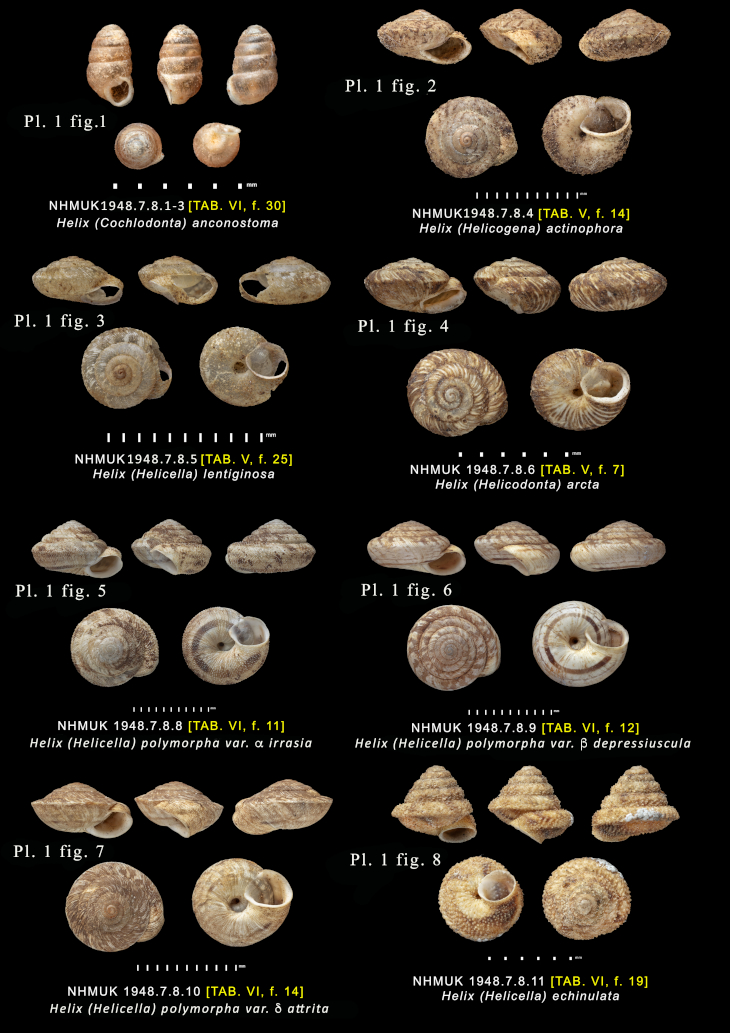
Plate 1. Photographs of specimens from the 1948 accession of figured specimens from Lowe, 1831. Scale bar in 1 mm intervals. |
|||||||||||||||||||||||||||||||||||||||||||||||||||||||||||||||||||||||||||||||||||||||||||||||||||||||||||||||||||||||||||||||||||||||||||||||||||||||||||||||||||||||||||||||||||||||||||||||||||||||||||||||||
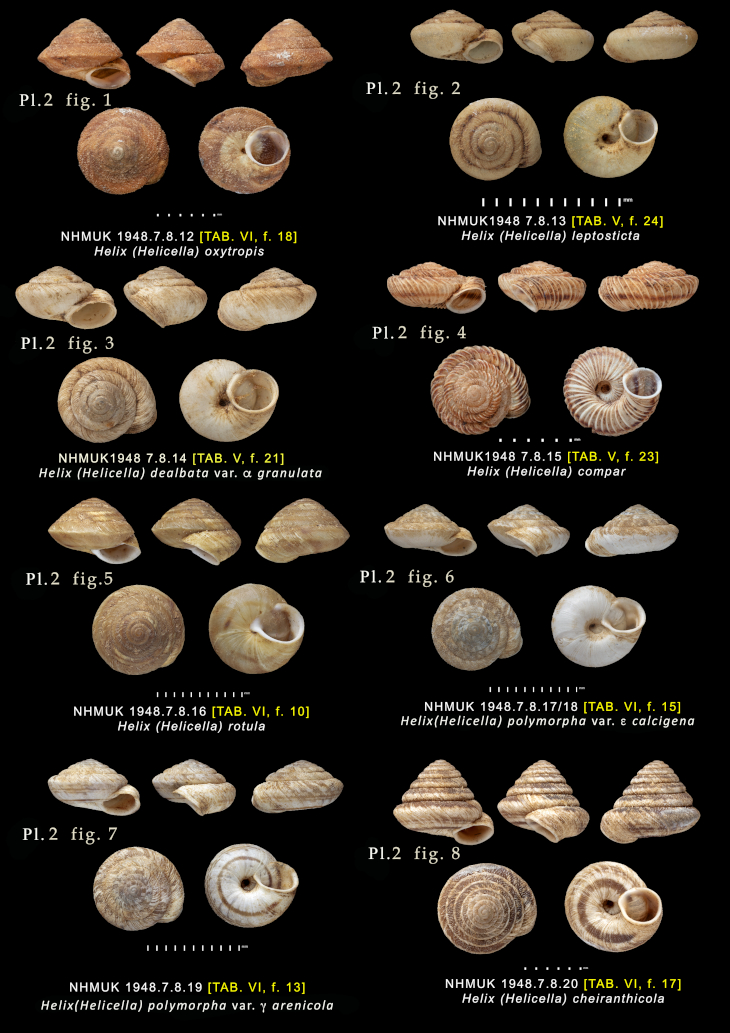
Plate 2. Photographs of specimens from the 1948 accession of figured specimens from Lowe, 1831. Scale bar in 1 mm intervals. |
|||||||||||||||||||||||||||||||||||||||||||||||||||||||||||||||||||||||||||||||||||||||||||||||||||||||||||||||||||||||||||||||||||||||||||||||||||||||||||||||||||||||||||||||||||||||||||||||||||||||||||||||||
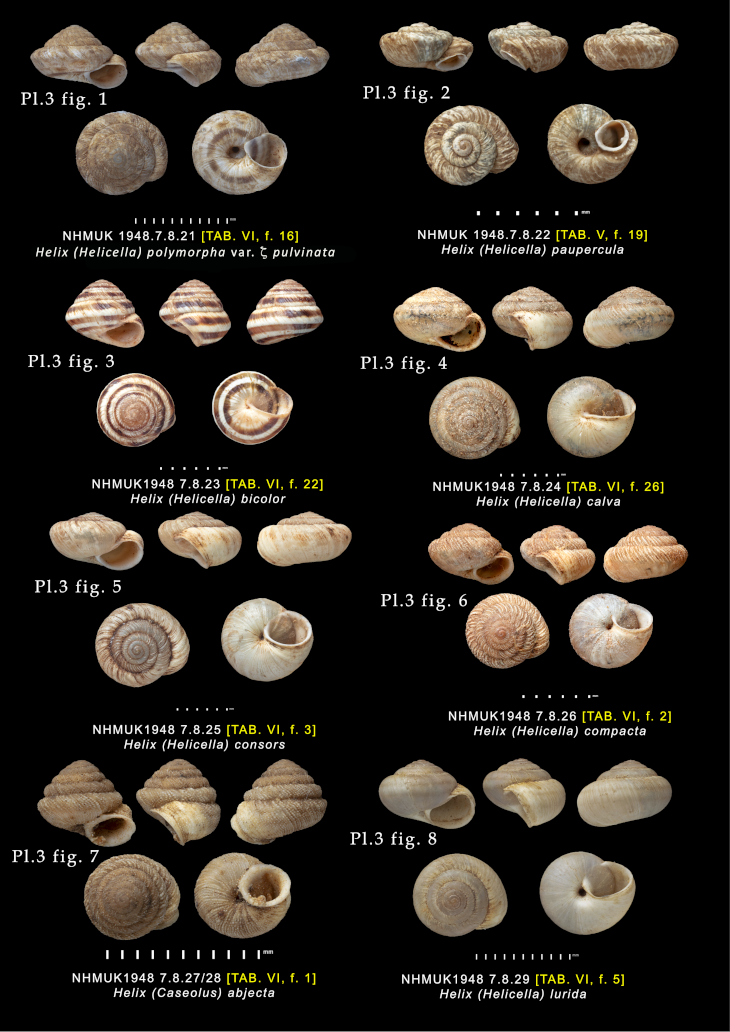
Plate 3. Photographs of specimens from the 1948 accession of figured specimens from Lowe, 1831. Scale bar in 1 mm intervals. |
|||||||||||||||||||||||||||||||||||||||||||||||||||||||||||||||||||||||||||||||||||||||||||||||||||||||||||||||||||||||||||||||||||||||||||||||||||||||||||||||||||||||||||||||||||||||||||||||||||||||||||||||||
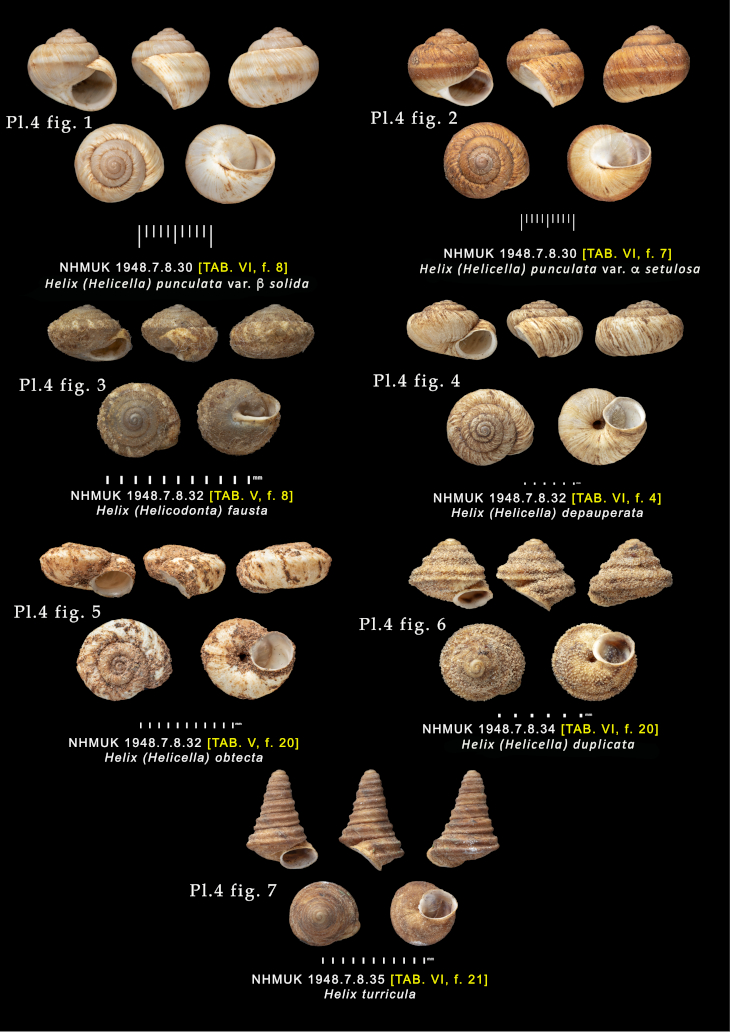
Plate 4. Photographs of specimens from the 1948 accession of figured specimens from Lowe, 1831. Scale bar in 1 mm intervals. |
|||||||||||||||||||||||||||||||||||||||||||||||||||||||||||||||||||||||||||||||||||||||||||||||||||||||||||||||||||||||||||||||||||||||||||||||||||||||||||||||||||||||||||||||||||||||||||||||||||||||||||||||||
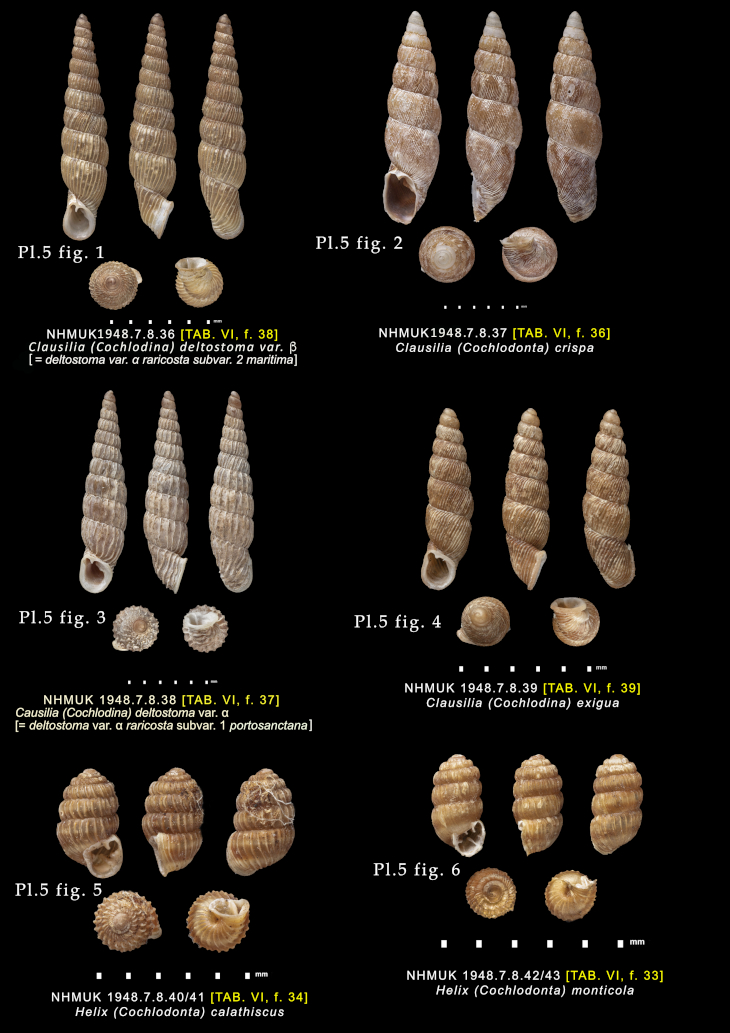
Plate 5. Photographs of specimens from the 1948 accession of figured specimens from Lowe, 1831. Scale bar in 1 mm intervals. |
|||||||||||||||||||||||||||||||||||||||||||||||||||||||||||||||||||||||||||||||||||||||||||||||||||||||||||||||||||||||||||||||||||||||||||||||||||||||||||||||||||||||||||||||||||||||||||||||||||||||||||||||||
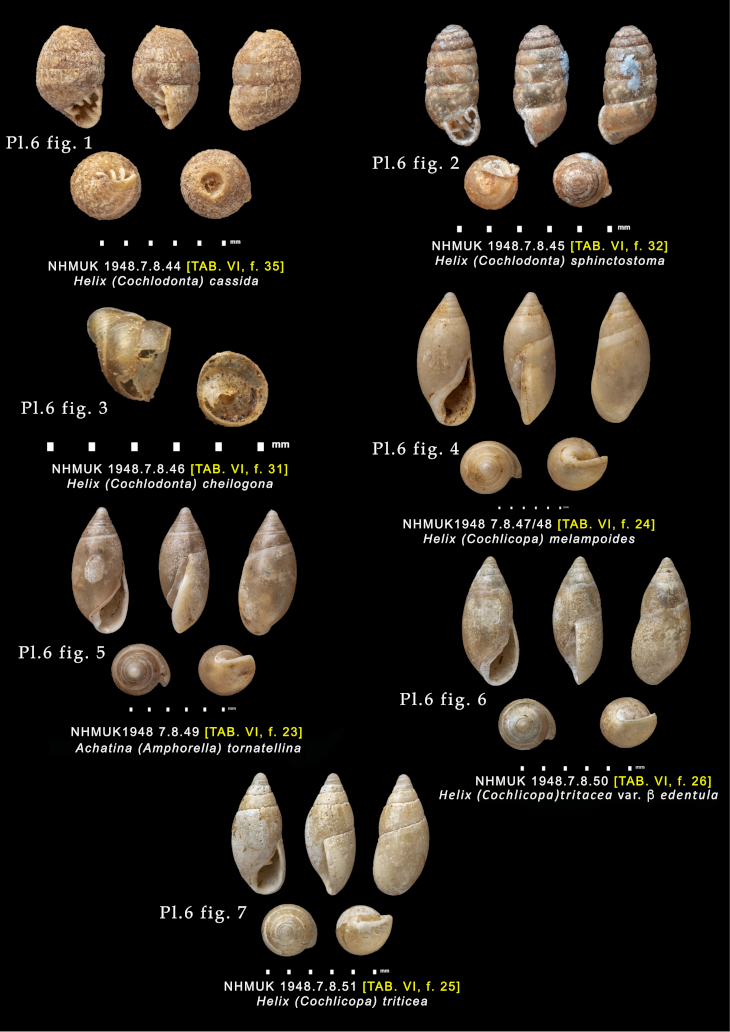
Plate 6. Photographs of specimens from the 1948 accession of figured specimens from Lowe, 1831. Scale bar in 1 mm intervals. |
|||||||||||||||||||||||||||||||||||||||||||||||||||||||||||||||||||||||||||||||||||||||||||||||||||||||||||||||||||||||||||||||||||||||||||||||||||||||||||||||||||||||||||||||||||||||||||||||||||||||||||||||||
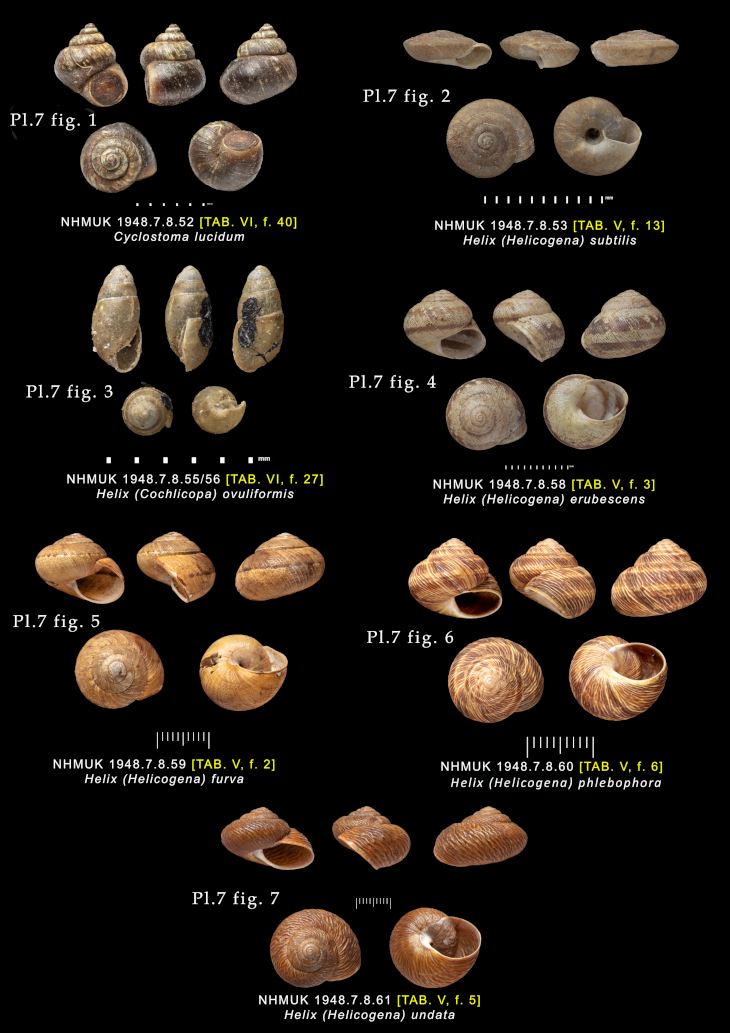
Plate 7. Photographs of specimens from the 1948 accession of figured specimens from Lowe, 1831. Scale bar in 1 mm intervals. |
|||||||||||||||||||||||||||||||||||||||||||||||||||||||||||||||||||||||||||||||||||||||||||||||||||||||||||||||||||||||||||||||||||||||||||||||||||||||||||||||||||||||||||||||||||||||||||||||||||||||||||||||||
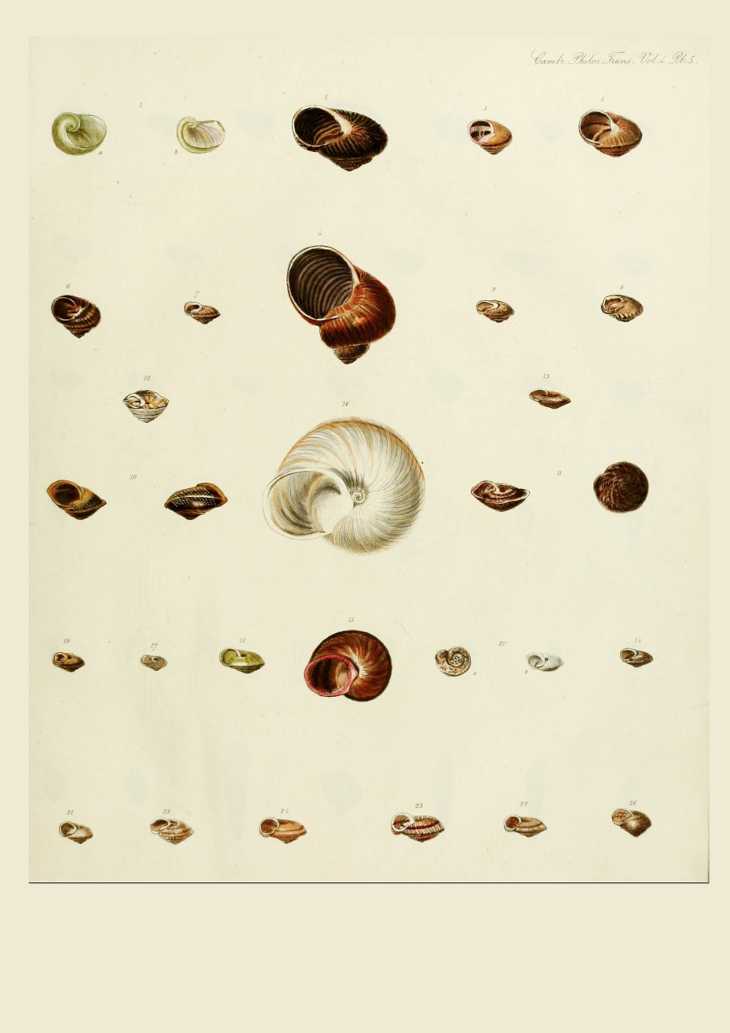
Plate 8. Reproduction of TAB. V from Lowe, 1831. |
|||||||||||||||||||||||||||||||||||||||||||||||||||||||||||||||||||||||||||||||||||||||||||||||||||||||||||||||||||||||||||||||||||||||||||||||||||||||||||||||||||||||||||||||||||||||||||||||||||||||||||||||||
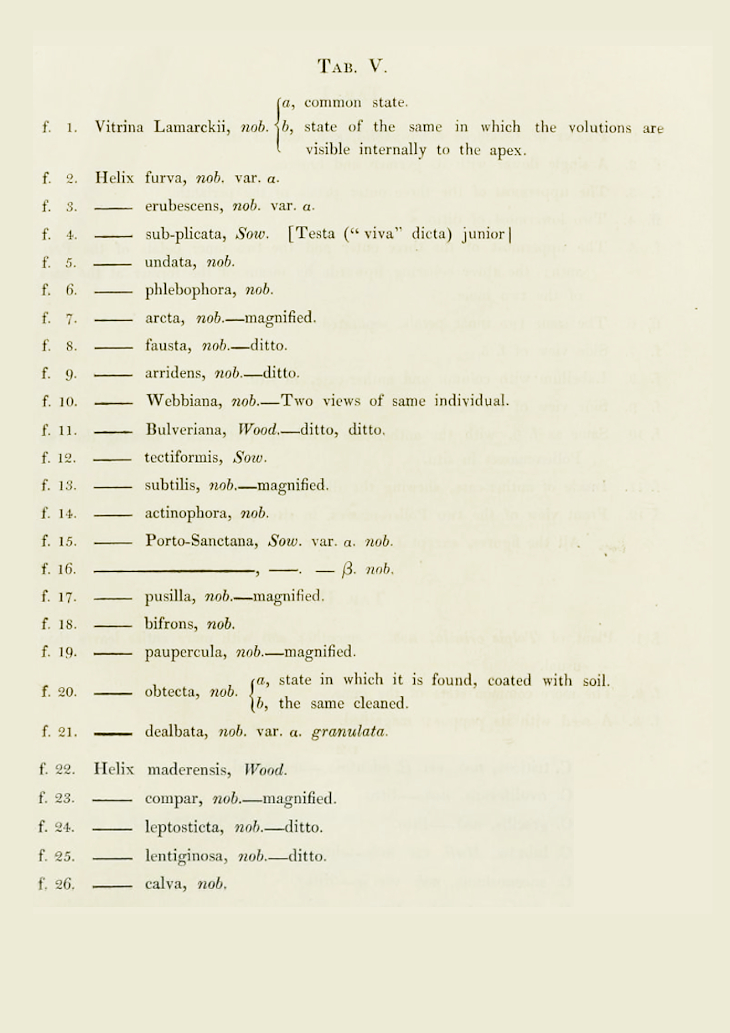
Plate 9. Reproduction of the legend for TAB. V from Lowe, 1831. |
|||||||||||||||||||||||||||||||||||||||||||||||||||||||||||||||||||||||||||||||||||||||||||||||||||||||||||||||||||||||||||||||||||||||||||||||||||||||||||||||||||||||||||||||||||||||||||||||||||||||||||||||||
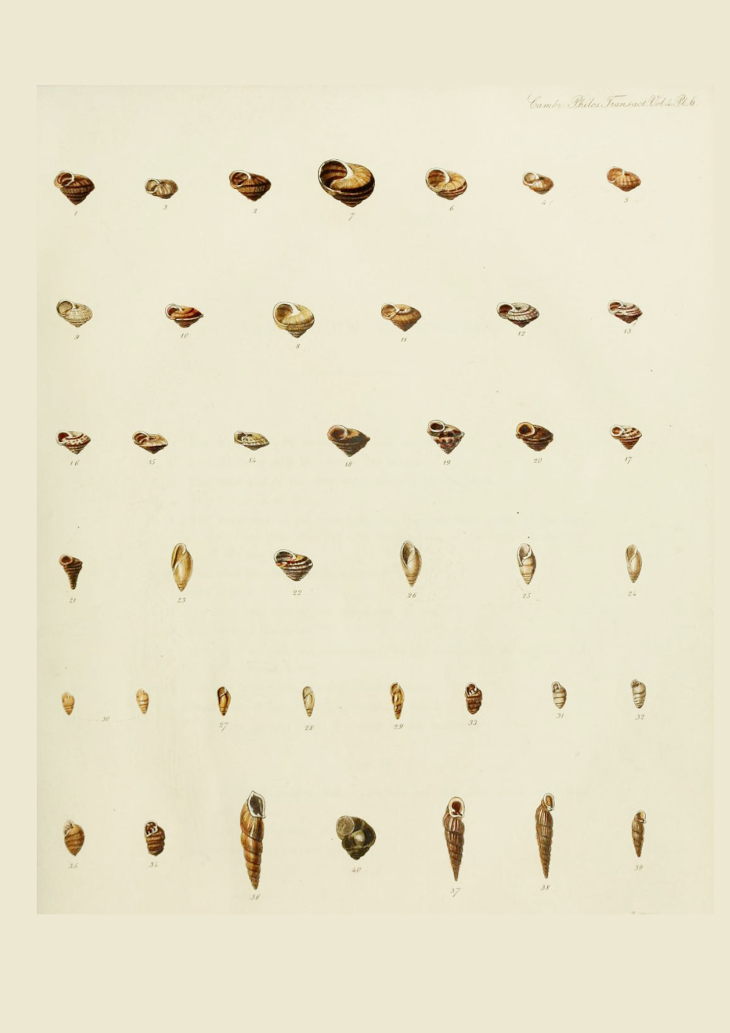
Plate 10. Reproduction of TAB. VI from Lowe, 1831. |
|||||||||||||||||||||||||||||||||||||||||||||||||||||||||||||||||||||||||||||||||||||||||||||||||||||||||||||||||||||||||||||||||||||||||||||||||||||||||||||||||||||||||||||||||||||||||||||||||||||||||||||||||
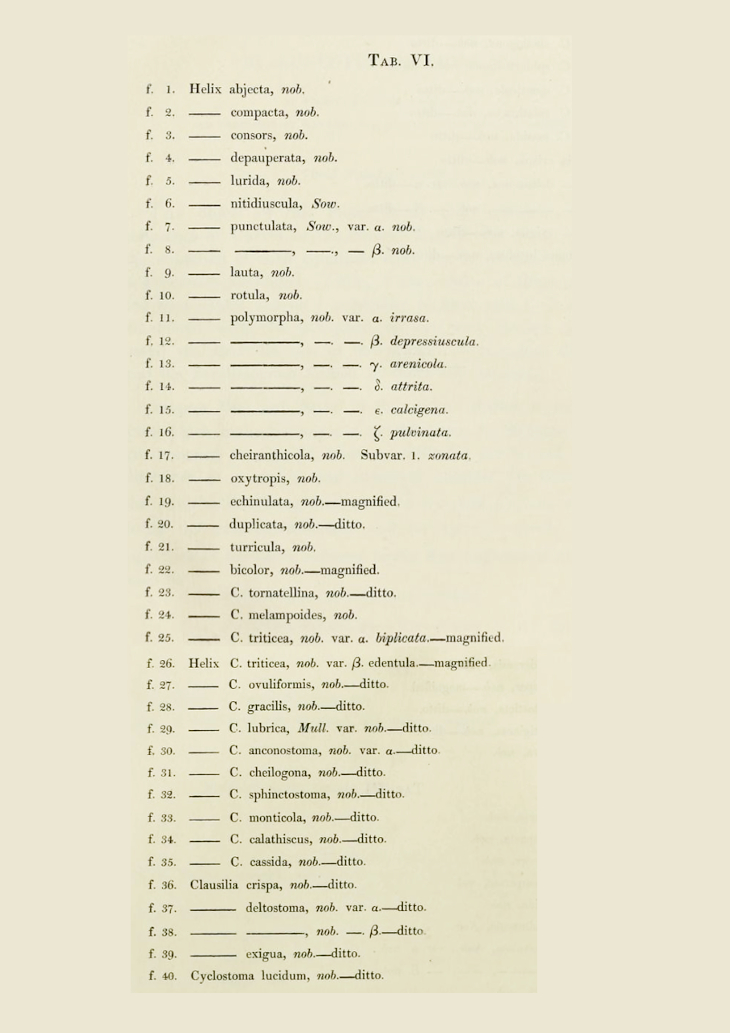
Plate 11. Reproduction of the legend for TAB. VI from Lowe, 1831. |
|
|
P. Graham Oliver Klaus Groh Jonathan D. Ablett Thierry Backeljau Bram van der Bijl Amy Geraghty Sigrid Hof Lee Ismail Henk K. Mienis Holly Morgenroth Richard C. Preece Sankurie Pye Gary Rosenberg Ellen E. Strong Jennifer Trimble Harriet Wood |
| Oliver P.G. et al., 2023. Recognising Type Specimens in a Dispersed Collection. The Macaronesian Land Mollusca Described by R. T. Lowe. Colligo, 6(2). https://revue-colligo.fr/?id=89. |

